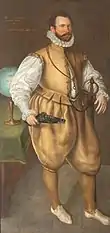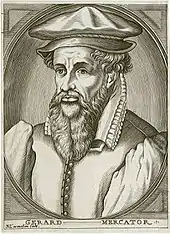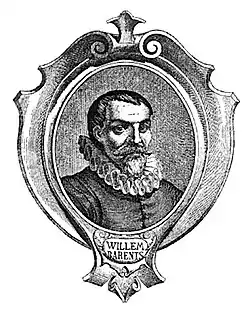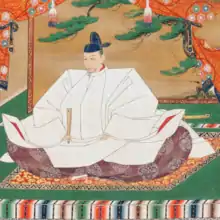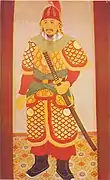1590s
The 1590s decade ran from January 1, 1590, to December 31, 1599.
| Millennium: | 2nd millennium |
| Centuries: | |
| Decades: | |
| Years: | |
| Categories: |
|
Events
1590
January–June
- January 4 – The Cortes of Castile approves a new subsidy, the millones.
- March 4 – Maurice of Nassau, Prince of Orange, takes Breda, by concealing 68 of his best men in a peat-boat, to get through the impregnable defences.
- March 14 – Battle of Ivry: Henry IV of France again defeats the forces of the Catholic League, under Charles, Duke of Mayenne.[1]
- May–August – Henry IV of France unsuccessfully attempts to besiege Paris. Henry is forced to raise the siege, when Alexander Farnese, Duke of Parma comes to its rescue with a Spanish army.
- May 17 – Anne of Denmark is crowned queen consort of Scotland, at Holyrood Abbey in Edinburgh.[2]
- May 21 – The Treaty of Constantinople is signed.
July–December
- August 18 – John White, governor of the Colony of Roanoke, returns from a supply-trip to England and finds his settlement deserted. After the unsuccessful search, he returns to England on October 24.
- September 5 – Alexander Farnese's army forces Henry IV of France to lift the siege of Paris.
- September 15 – Urban VII succeeds Sixtus V, as the 228th pope; he dies of malaria twelve days later.[3]
- September 15 – The Neulengbach earthquake causes significant damage and some loss of life, in Lower Austria and Vienna; the effects are felt as far as Bohemia and Silesia.
- December 5 – Gregory XIV succeeds Urban VII, as the 229th pope.[4]
- December 7 – North Berwick witch trials: Agnes Sampson is questioned by King James VI of Scotland, and confesses to practising witchcraft.[5]
Date unknown
- Orthodox Patriarch Meletius I of Alexandria succeeds Silvester.
- Japan is united by Toyotomi Hideyoshi.
- The Spanish are pushed out of southern Gelderland, by the Dutch forces.
1591
January–June
- March 13 – Battle of Tondibi: In Mali, forces sent by the Saadi Dynasty ruler of Morocco, Ahmad al-Mansur, and led by Judar Pasha, defeat the fractured Songhai Empire, despite being outnumbered by at least five to one.[6]
- April 10 – English merchant James Lancaster sets off on a voyage to the East Indies.[7]
- April 21 – Japanese tea-master Sen no Rikyū commits seppuku, on the order of Toyotomi Hideyoshi.
- May 15 – In Russia, Tsarevich Dimitri, son of Ivan the Terrible, is found dead in mysterious circumstances, at the palace in Uglich. The official explanation is that he has cut his own throat during an epileptic seizure. Many believe he has been murdered by his rival, Boris Godunov, who becomes tsar.
- May 24 – Sir John Norreys, with an expeditionary force sent by Queen Elizabeth I of England, takes the town of Guingamp after a brief siege, on behalf of Henry of Navarre.
- May 30 – Timbuktu is captured by an expedition of Arma people, sent by the Saadi ruler of Morocco, and led by Judar Pasha.
- May 30 – Zutphen is captured by the Dutch and English, under Maurice of Nassau.
- June 10 – Deventer is captured by the Dutch, under Maurice of Nassau.
July–December
- July – Battle of Bhuchar Mori in Gujarat: the Mughal Empire gains a decisive victory over the Nawanagar State.
- July 22 – The Durtnell (Dartnell) family of Brasted, Kent, England, begin to work as building contractors. The business continues under thirteen generations of the family until ceasing to trade in 2019.[8]
- July 25 – Siege of Knodsenburg: Maurice of Nassau and Francis Vere defeat the Duke of Parma outside Nijmegen.
- August – Robert Devereux, Earl of Essex leads an English army in support of the Protestant Henry IV of France at the Siege of Rouen.[7]
- August–September – During this year's Atlantic hurricane season, probably the most severe of the pre-1600 seasons, at least eight intense hurricanes occur.
- August 30–September 1 – Battle of Flores off Flores Island (Azores): the Spanish fleet is victorious over the English; English ship Revenge is captured on September 1 (and Richard Grenville fatally wounded) but soon afterwards lost with all hands in a week-long storm, along with a large number of the Spanish ships.
- September 14 – Siege of Hulst: Hulst is captured by Maurice.
- October 8 – The Separation Edict, a law preventing social mobility in Japan, is promulgated by Toyotomi Hideyoshi.
- October 21 – Siege of Nijmegen: Nijmegen is captured by Maurice.
- October 26 – The Portuguese invasion of Jaffna Kingdom begins.
- October 29 – Pope Innocent IX succeeds Pope Gregory XIV, becoming the 230th pope.[9]
Date unknown
- The city of Hyderabad, India is founded by Muhammad Quli Qutb Shah.[10]
- The Rialto Bridge in Venice, designed by Antonio da Ponte, is completed.
- The first of the Conimbricenses commentaries on Aristotle, by the Jesuits of the University of Coimbra, is published. [11]
- The Siamese-Cambodian War begins.
- The defeated Askia Dynasty move to the Dendi province in modern-day Niger.
1592
January–June
- January 30 – Pope Clement VIII (born Ippolito Aldobrandini) succeeds Pope Innocent IX, who died one month earlier, as the 231st pope.[12] He immediately recalls the Sixtine Vulgate.
- February 7 – George Gordon, 1st Marquess of Huntly, sets fire to Donibristle Castle in Scotland and murders James Stewart, 2nd Earl of Moray.
- March 3 – Trinity College Dublin, Ireland's oldest university, is founded.[13]
- March 14 – Ultimate Pi Day: the largest correspondence between calendar dates and significant digits of pi since the introduction of the Julian calendar according to the American method of writing the number of the month prior to the day.
- April 4 – The future Henry IV of France, King designate of Henry III of France, announces in a declaration, so-called "Expedient," his intention to take instruction in, and convert to, the Catholic religion.
- April 13 – The Japanese invasions of Korea (1592–98) begin with the Siege of Busanjin.
- April 24 – Battle of Sangju: The Japanese are victorious over the Koreans (Joseon).
- April 28 – Battle of Ch'ungju: Japan inflicts a decisive defeat on Korea.
- May 7
- Battle of Okpo: The Korean navy is victorious over Japan.
- 1592–1593 Malta plague epidemic begins with Tuscan galleys arriving from Alexandria in Egypt.
- May 20–August 19 – Battle of Flores (Anglo-Spanish War (1585–1604)), a series of naval engagements in the Azores in which the English are victorious, taking the great Portuguese carrack Madre de Deus on or about August 3.
- May 29 – Battle of Sacheon: Korean admiral Yi Sun-sin destroys all 13 Japanese ships taking part, using his improved turtle ship for the first time in battle.
- June 2 – Battle of Dangpo:The Korean navy is again victorious over Japan.
- June 10–19 – Siege of Bihać in the Kingdom of Croatia, by Telli Hasan Pasha (Hasan Predojević) of the Ottoman Empire. Bihać is captured and lost for Croatia forever.
July–December
- July 20 – The Japanese capture the Korean capital Hanyang, causing Seonjo to request the assistance of Ming dynasty Chinese forces, who recapture the city a year later.
- July 30 – Alonso de Sotomayor petitions the viceroy of Peru for more troops to help resist attacks by Indians and English pirates.
- August – 1592–1593 London plague breaks out in England.
- August 9 – English explorer John Davis, commander of the Desire, probably discovers the Falkland Islands.
- August 14 – Battle of Hansan Island: The Korean navy defeats the Japanese.[14]
- September 1 – Battle of Busan: The Korean fleet makes a surprise attack on the Japanese but fails to break their supply lines to Busan.
- September 7 – The captured Madre de Deus enters Dartmouth harbour in England and is then subjected to mass theft.
- October 5 – Siege of Jinju: The Korean navy is victorious over the Japanese.
- November 3 – The city of San Luis Potosí is founded.
- November 9 – The Sixto-Clementine Vulgate is promulgated.[15]
- November 17 – John III is succeeded by his son Sigismund as King of Sweden.
- November 12 – The Collegium Melitense is founded in Malta by Bishop Garagallo.
Date unknown
- William Cecil, 1st Baron Burghley, chief adviser of Queen Elizabeth I of England, is taken seriously ill.
- Negotiations begin for the annulment of the childless marriage of Henry IV of France and Marguerite of Valois.
- The Confucian shrine of Munmyo in Korea is destroyed by fire.
- The Population Census Edict is promulgated in Japan by Toyotomi Hidetsugu.
- Henry Constable's Diana, one of the first sonnet sequences in English, is published in London.
1593
January–December
- January – Siege of Pyongyang (1593): A Japanese invasion is defeated in Pyongyang by a combined force of Korean and Ming troops.[16]
- January 18 – Siamese King Naresuan, in combat on elephant back, kills Burmese Crown Prince Mingyi Swa on Monday, Moon 2 Waning day 2, Year of the Dragon, Chulasakarat 954, reckoned as corresponding to January 25, 1593, of the Gregorian calendar, and commemorated as Royal Thai Armed Forces Day.
- January 27 – The Roman Inquisition opens the seven-year trial of scholar Giordano Bruno.
- February 2 – Battle of Piątek: Polish forces led by Janusz Ostrogski are victorious.[17]
- February 12 – Battle of Haengju: Korea defeats Japan.[18]
- March 7 (February 25 Old Style) – The Uppsala Synod discontinues; the Liturgical Struggle between the Swedish Reformation and Counter-Reformation ends in Sweden.
- March 14 – The Pi Day, giving the most digits of Pi when written in mm/dd/yyyy format (this year Flemish mathematician Adriaan van Roomen arrives at 15 decimal places of Pi using the polygon approximation method).
- April 18 – Anglo-Spanish War: Naval Battle of Blaye in the Gironde estuary sees a Spanish victory over the blockading English fleet, allowing the Spanish to relieve the French Catholic garrison of Blaye.[19]
- After April – William Shakespeare's poem Venus and Adonis probably becomes his first published work, printed in London from his own manuscript. In his lifetime it will be his most frequently reprinted work: at least nine times.[20]
- May 5 – "Dutch church libel" bills posted in London threaten Protestant refugees from France and the Netherlands, alluding to Christopher Marlowe's plays.
- May 12 – English dramatist Thomas Kyd is arrested over the "Dutch church libel". "Atheist" literature found in his home is claimed to be Marlowe's.
- May 18 – A warrant for the arrest of Christopher Marlowe is issued. On May 20 he presents himself to the Privy Council.
- May 30 – Christopher Marlowe is stabbed to death in a dispute over a bill at a lodging house in Deptford.[21]
- June 7 – Battle of Salbertrand in Piedmont: Victory of François de Bonne, Duke of Lesdiguières, over the Spanish of Rodrigue Alvarez of Toledo, allies of Charles Emmanuel I, Duke of Savoy.[22]
- June 22 – Battle of Sisak in Croatia: The Habsburgs defeat the Ottoman Empire.[23]
- July 25 – As he promised in January, Henry IV of France abjures Protestantism at the Basilica of Saint-Denis.[24] Legend attributes to him the saying Paris vaut bien une messe ("Paris is well worth a mass").[25]
- July 29 – The Long War breaks out in Hungary between the Habsburgs and the Ottomans.
- October 24–25 – Supposed date of the event described in the 1593 transported soldier legend.
Date unknown
- Mihai Viteazul becomes prince of Walachia.
- Robert Bellarmine's Disputationes de Controversiis Christianae Fidei adversus hujus temporis Haereticos ("Controversiae") concludes publication in Ingolstadt.
- Henry Constable's Spirituall Sonnettes are written.[26]
- The parish of Laukaa was founded.[27]
- Khwaja Usman takes shelter in Goyghor Mosque after the Afghan rebellion against the Subahdar of Mughal Bengal, Man Singh I.[28]
- Irish pirate queen Grace O'Malley meets with Queen Elizabeth I of England at Greenwich.[29]
- c. 1593-1604 – According to John Warwick Montgomery, the Rosicrucian manifestos are initially composed by Tobias Hess, in anticipation of the opening of the vault in 1604, according to Simon Studion's apocalyptic timetable.
1594
January–June
- March 21 – Henry IV enters his capital of Paris for the first time.
- April 17 – Hyacinth of Poland is canonized.
- May
- June 5 – Willem Barents makes his first voyage to the Arctic Ocean, in search of the Northeast Passage.
- June 11 – Philip II of Spain recognizes the rights and privileges of the local nobles and chieftains in the Philippines, which paves the way for the stabilization of the rule of the Principalía.
- June 22–23 – Anglo-Spanish War: Action of Faial – In the Azores, an English attempt to capture the large Portuguese carrack Cinco Chagas, reputedly one of the richest ever to set sail from the East Indies, causes it to explode with the loss of all but 13 of the 700 on board, and all the treasure.
July–December
- July 1 or July 2 – Anglo-Spanish War: Action of Atacames Bay – English privateer Richard Hawkins in the Dainty is attacked and captured by a Spanish squadron off Esmeraldas, Ecuador.
- July 3 – The Ayutthayan–Cambodian War (1591–1594) concludes when Naresuan, ruler of the Ayutthaya Kingdom, sacks Longvek, capital of Cambodia.
- July 22 – After a two-month siege, the city of Groningen submits to Dutch troops, bringing the whole northern Netherlands under the Dutch Republic.
- August 30 – Diplomats meet at Stirling Castle for the Masque at the baptism of Prince Henry.[30]
- October 9 – The Campaign of Danture, which began on July 5 as part of the Sinhalese–Portuguese War, concludes with a decisive victory by forces of the Kingdom of Kandy over the Portuguese Empire, reversing near-total control of Sri Lanka by Portugal.
Date unknown
- St. Paul's College is founded in Macau by Jesuits, being the first western style university in the far east.
- In Amsterdam, the Compagnie van Verre is created, with the goal of breaking the Portuguese monopoly on spice trade.
- Tulip bulbs planted by Carolus Clusius in the Hortus Botanicus Leiden, Holland, first flower.
- The city of Pompeii is rediscovered after its loss following the eruption of Mount Vesuvius.
1595
January–June
- January – Mehmed III succeeds Murad III, as sultan of the Ottoman Empire.
- January 17 – During the French Wars of Religion, Henry IV of France declares war on Spain.
- April 8 (March 29 O.S.) – Combined Taungoo–Lan Na armies break the rebel Thado Dhamma Yaza's siege of Taungoo, in modern-day Myanmar.
- April 15 – Sir Walter Raleigh travels up the Orinoco River, in search of the fabled city of El Dorado.[7]
- May 18 – The Treaty of Teusina brings to an end the Russo-Swedish War (1590–95).[31]
- May 24 – The Nomenclator of Leiden University Library appears, the first printed catalog of an institutional library.
- May 29 – George Somers and Amyas Preston travel to aid Raleigh's El Dorado expedition but failing to meet him instead raid the Spanish Province of Venezuela
- June 9 – Battle of Fontaine-Française: Henry IV of France defeats the Spanish, but is nearly killed due to his rashness.
July–December
- July 21 – A Spanish expedition led by navigator and explorer Álvaro de Mendaña de Neira makes the first European landing in Polynesia, on the Marquesas Islands.
- July 23 – The Spanish raid Cornwall, England.[32]
- August 23 – Battle of Calugareni: The Wallachians, led by Michael the Brave, accomplish a great tactical victory against a vast army of Turks, led by Sinan Pasha.
- August 28 – Sir Francis Drake and Sir John Hawkins depart from England, on their final voyage to the Spanish Main, which ends in both of their deaths.[7]
- September 2 – Battle of the Lippe (Eighty Years' War): Spanish cavalry, led by Cristóbal de Mondragón (aged over 80), defeat combined forces of the Dutch Republic and England led by Philip of Nassau (who dies of wounds received), on the banks of the river Lippe in Germany.
- October 26 – Battle of Giurgiu: Michael the Brave, led by Transylvanian Prince Sigismund Báthory, again defeats the Turkish army led by Sinan Pasha, pushing them on the east side of the Danube.
- December 9 – Probable first performance of William Shakespeare's Richard II in London.
- December 14 – Sultan Murad, 4th son of Emperor Akbar of the Mughal Empire invades Ahmednagar Sultanate which is defended by Chand Bibi.
Date unknown
- The Austrians incite a rebellion against the Ottomans in Bulgaria.
- The Riksdag of the Estates at Söderköping in Sweden elects the Lutheran Duke Charles as the country's regent, in place of Sigismund III Vasa, King of Poland and Sweden.
- Probable first performance of William Shakespeare's plays Romeo and Juliet and A Midsummer Night's Dream in London.[32]
- Many sugar plantations in São Tomé are destroyed by a large slave uprising[33]
1596
January–June
- January 6–20 – An English attempt led by Francis Drake to cross the Isthmus of Panama ends in defeat.
- January 28 – Francis Drake dies of dysentery off Portobelo.
- February 14 – Archbishop John Whitgift begins building his hospital at Croydon.
- April 9 – Siege of Calais: Spanish troops capture Calais.
- May 18 – Willem Barents leaves Vlie, on his third and final Arctic voyage.
- June – Sir John Norreys and Sir Geoffrey Fenton travel to Connaught, to parley with the local Irish lords.
- June 10 – Willem Barents and Jacob van Heemskerk discover Bear Island.
- June 17 – Willem Barents discovers Spitsbergen.
- June 24 – Cornelis de Houtman arrives in Banten, the first Dutch sailor to reach Indonesia..
July–December
- July 5 – Capture of Cádiz: An English fleet, commanded by Robert Devereux, 2nd Earl of Essex, and Lord Howard of Effingham, sacks Cádiz.
- July 14 – King Dominicus Corea (Edirille Bandara) is beheaded by the Portuguese in Colombo, Ceylon.
- August – David Fabricius discovers the star Mira.
- September 20 – Diego de Montemayor founds the city of Monterrey, Mexico.
- October 8–10 – The Union of Brest: The Ukrainian Church west of the Dnieper becomes known as the Ukrainian Rite of Catholicism, whereas the East officially renounces the authority of the Pope.[34]
- October 18 – The Second Armada, a Spanish fleet sent to attack England in revenge for the raid on Cadiz, is wrecked in storms off Cape Finisterre; nearly 5,000 men and 44 ships are lost including five galleons
- October 19 – The Spanish galleon San Felipe founders in Japan, leading to 26 Christians being martyred the next year.
- October 24–26 – Battle of Keresztes: The Turks defeat a combined Habsburg–Transylvanian army.[35]
- November 25 – The Cudgel War began in Finland (at the time part of Sweden), when poor peasants rose up against the troops, nobles and cavalry who taxed them.[36]
Date unknown
- Elizabeth I of England decrees that all Africans should be removed from the British realm, in reaction to the food crisis.[37]
- The first water closet, by Sir John Harington, is installed in a manor near Kelston in England.
- King Sigismund III Vasa moves the capital of Poland from Kraków to Warsaw.
- Sidney Sussex College, Cambridge, is founded.
- The Black Death hits parts of Europe.
- Dutch ships, commanded by Frederick de Houtman, reach Sumatra and Java for the first time.
- The fourth of a five year run of poor harvests, largely caused by the weather, a pattern typical of the last third of the century. This causes famine throughout Europe, which leads to food riots in Britain.[38]
- Serb Uprising of 1596–97
1597
January–June
- January 24 – Battle of Turnhout: Maurice of Nassau defeats a Spanish force under Jean de Rie of Varas, in the Netherlands.[39]
- February – Bali is discovered, by Dutch explorer Cornelis Houtman.
- February 5 – In Nagasaki, Japan, 26 people are martyred by crucifixion. They practiced Catholicism, and were taken captive after all forms of Christianity were outlawed the previous year.
- February 8 – Sir Anthony Shirley, England's "best-educated pirate", raids Jamaica.
- February 24 – The last battle of the Cudgel War was fought on the Santavuori Hill in Ilmajoki, Ostrobothnia.[40]
- March 11 – Amiens is taken by Spanish forces.
- After April 10 – The Serb uprising of 1596–97 ends in defeat for the rebels, at the field of Gacko (Gatačko Polje).
- April 23 – Probable first performance of William Shakespeare's The Merry Wives of Windsor.
- April 27 – Johannes Kepler marries Barbara Muhleck.[41]
July–December
- c. July – Thomas Nashe and Ben Jonson's satirical play The Isle of Dogs is performed at the Swan Theatre in London; it is immediately suppressed by the authorities and no copy survives.
- July 14 – Scottish poet Alexander Montgomerie is declared an outlaw, after the collapse of a Catholic plot.
- August 13 – The Siege of Namwon begins in Korea.
- August 14 – First Dutch Expedition to Indonesia: A Dutch expedition commanded by Cornelis de Houtman returns to Amsterdam, after having successfully reached Java. This achievement opens the Spice trade, which had until then been monopolised by the Portuguese, to the Dutch, who in the next years launch several more expeditions to the Indies.
- August 17 – Islands Voyage: Robert Devereux, 2nd Earl of Essex, and Sir Walter Raleigh set sail on an expedition to the Azores.
- August 19 – Rheinberg capitulates to forces led by Maurice of Naussau.
- August 24 – Christian IV of Denmark-Norway refuses to let Tycho Brahe return to Denmark.
- August 28 – Imjin War: Battle of Chilcheollyang – The Japanese fleet defeats the Koreans, in their only naval victory of the war.[42]
- September 25 – Amiens is retaken from the Spanish by Anglo-French forces, led by Henry IV of France, after a four-month siege.
- October – John Gerard, a Jesuit priest, escapes from the Tower of London.
- October/November – The 3rd Spanish Armada is dispersed by a storm; a number of Spanish ships are captured off the coasts of Wales, Cornwall and Devon.
- October 26 – Battle of Myeongnyang: The Koreans, commanded by Yi Sunsin, are victorious over a Japanese invasion fleet.
- November 12 – Lingen capitulates to forces led by Maurice of Nassau.
Date unknown
- Abbas I ends the Uzbek raids on his lands.
- Yaqob succeeds his father Sarsa Dengel, as Emperor of Ethiopia at the age of 7.
- Jacopo Peri writes Dafne, now recognised as the first opera.
- The first edition of Francis Bacon's Essays is published.[43]
- Andreas Libavius publishes Alchemia, a pioneering chemistry textbook.[44]
- 12 million pesos of silver cross the Pacific. Although it is unknown just how much silver flowed from the Spanish base of Manila in the Philippines to the Ming Dynasty of China, it is known that the main port for the Mexican silver trade—Acapulco—shipped out 150,000 to 345,000 kg (4 to 9 million taels) of silver annually from this year to 1602.
- Tobias Hess corresponds with Simon Studion and agrees with him that the Papacy must fall in 1604.
1598
January–June
- February 21 – Boris Godunov seizes the throne of Russia, following the death of his brother-in-law, Tsar Feodor I; the Time of Troubles starts.
- April 13 – Edict of Nantes (promulgated April 30): Henry IV of France grants French Huguenots equal rights with Catholics; this is considered the end of the French Wars of Religion.[45]
- May – Tycho Brahe's star catalogue Astronomiæ instauratæ mechanica, listing the positions of 1,004 stars, is published.
- May 2 – The Peace of Vervins ends the war between France and Spain.
July–December
- July – Philosopher Tommaso Campanella moves from Naples to Calabria, where he would be involved in a revolt against the rule of the Spanish viceroy the following year.[46]
- August 14 – Battle of the Yellow Ford in Ireland: Hugh O'Neill, Earl of Tyrone, gains victory over an English expeditionary force under Henry Bagenal, in the Nine Years' War against English rule.
- September 13 – Philip III of Spain starts to rule, on the death of his father.
- September 25 – Battle of Stångebro at Linköping in Sweden: The Catholic King Sigismund of Sweden and Poland is defeated in his attempt to resume control of Sweden by the Protestant forces of his uncle, Charles. Sigismund is deposed shortly thereafter.[47]
- Autumn – Second Dutch Expedition to Indonesia: After being separated from the main Dutch fleet of Admiral Wybrand Van Warwyck, three ships under Jacob Corneliszoon van Neck land on the island which they name Mauritius, after Maurice, Prince of Orange, and sight the dodo.
- December 16 (November 19 (lunar calendar)) – Battle of Noryang: An allied Korean and Chinese fleet under Korean Admiral Yi Sun-sin and Chinese Admiral Chen Lin defeats the Japanese navy, ending the Japanese invasions of Korea (1592–98).[48]
- December 21 – Battle of Curalaba: The revolting Mapuche, led by cacique Pelantaro, inflict a major defeat on Spanish troops in southern Chile; all Spanish cities south of the Bío Bío River eventually fall victim to the Destruction of the Seven Cities by the Mapuches, and all conquest of Mapuche territories by Europeans practically ceases, until the later 19th century Occupation of Araucanía.
Date unknown
- Carnival – Jacopo Peri's Dafne, the earliest known modern opera, is premièred at the Palazzo Corsini, Florence.[49]
- Pentecost – Calvinist congregations in Zürich introduce music into their services.[50]
- The Parliament of England passes the Vagabonds Act, that allows transportation of convicts to colonies.
- Illustrations of Ottoman Turkish and European riflemen, with detailed illustrations of their firearms, appear in Zhao Shizhen's book Shenqipu in this year, during the Ming Dynasty of China.
- The Spanish establish themselves in El Piñal, a trading port on the coast of China in the Pearl River Delta.[51]
- New Mexico is founded as the Kingdom of Nuevo México as part of the Viceroyalty of New Spain. The Kingdom eventually became a territory of Mexico, later the New Mexico Territory in the United States, and then the U.S. State of New Mexico.
1599
January–June
- January 8 – The Jesuit educational plan, known as the Ratio Studiorum, is issued.
- March 12 – Robert Devereux, 2nd Earl of Essex, is appointed Lord Lieutenant of Ireland, by Queen Elizabeth I of England.
- April 23 – The Earl of Essex arrives in Dublin at the head of 16,000 troops, the largest army ever seen in Ireland.
- May 16 – The Kalmar Bloodbath takes place in Kalmar, Sweden.
- May 29 – Essex takes Cahir Castle, supposedly the strongest in Ireland, after a short siege.[52]
- June 20 – The Synod of Diamper is convened.
July–December
- July – Second Dutch Expedition to Indonesia: A Dutch fleet returns to Amsterdam, carrying 600,000 pounds of pepper and 250,000 pounds of cloves and nutmeg.
- July 24 – Swedish King Sigismund III Vasa is dethroned by his uncle Duke Charles, who takes over as regent of the realm until 1604, when he becomes King Charles IX.
- August 15 – First Battle of Curlew Pass: Irish forces defeat the English.
- September 21 – The first reported performance at the Globe Theatre in London (erected over Spring/Summer), a presentation of Shakespeare's Julius Caesar (probably new to that year), is recorded by Swiss traveller Thomas Platter the Younger.
- September 28 – The Earl of Essex arrives back in England, disobeying the Queen's strict orders.
- October 18 – Battle of Sellenberk: Michael the Brave, Prince of Wallachia, defeats the army of Andrew Báthory near Șelimbăr, leading to the first recorded unification of the Romanians.
- November 10 – The Åbo Bloodbath takes place in Åbo, Swedish Finland.
- November – Persian embassy to Europe (1599–1602): A Persian embassy arrives in Moscow.
- December 19 – The forces of Minye Thihathu II of Toungoo and his ally Min Razagyi of the Kingdom of Mrauk U end the First Toungoo Empire by capturing Pegu (modern-day Bago, Myanmar).
Date unknown
- The first Capuchin friar is entombed in the Catacombe dei Cappuccini in Palermo (Sicily).
Births
1590
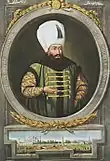
Emperor Ahmed I
- January 9 – Simon Vouet, French painter (d. 1649)[53]
- January 13 – Arthur Bell, English Franciscan martyr (d. 1643)
- January 20 – Edward Convers, American settler (d. 1663)
- January 27 – Charles Caesar, English politician and judge (d. 1642)
- January 30 – Lady Anne Clifford, 14th Baroness de Clifford (d. 1676)[54]
- February 7 – Barthold Nihus, Roman Catholic priest (d. 1657)
- March – Roger Ludlow, one of the founders of the colony (later the state) of Connecticut (d. 1664)
- March 6 – Margaret of the Blessed Sacrament, French Discalced Carmelite nun (d. 1660)
- March 10 – Dietrich Reinkingk, German lawyer and politician (d. 1664)
- March 18 – Manuel de Faria e Sousa, Spanish and Portuguese historian and poet (d. 1649)
- March 29 – Michael Reyniersz Pauw, Dutch businessman (d. 1640)
- April 7
- April 18 – Ahmed I, Ottoman Sultan (d. 1617)
- May – William Cecil, 17th Baron de Ros (d. 1618)
- May 3 – Franco Burgersdijk, Dutch logician (d. 1635)
- May 5
- May 12 – Cosimo II de' Medici, Grand Duke of Tuscany (d. 1621)[55]
- May 31 – Frances Carr, Countess of Somerset (d. 1632)
- June 1 – Isaac Manasses de Pas, Marquis de Feuquieres, French soldier (d. 1640)
- June 9 – Caspar Sibelius, Dutch Protestant minister (d. 1658)
- June 19 – Philip Bell, British colonial governor (d. 1678)
- June 24 – Samuel Ampzing, Dutch linguist and historian (d. 1632)
- June 29 – Edward Rodney, English politician (d. 1657)
- July 3 – Lucrezia Orsina Vizzana, Italian singer and composer (d. 1662)
- July 13 – Pope Clement X (d. 1676)[56]
- July 26 – Johannes Crellius, Polish–German theologian (d. 1633)
- August 6 – Count John Louis of Nassau-Hadamar (d. 1653)
- August 7 – Charles of Austria, Bishop of Wroclaw (d. 1624)
- August 9 – John Webster, colonial settler and governor of Connecticut (d. 1661)
- August 19 – Henry Rich, 1st Earl of Holland, English soldier (d. 1649)
- August 27 – Ferruccio Baffa Trasci, Italian bishop (d. 1656)
- August 30 – Anthony Stapley, English politician (d. 1655)
- September 12 – María de Zayas, Spanish writer (d. 1661)
- September 15 – Erasmus Earle, English barrister and politician (d. 1667)
- October 3 – Anna of Pomerania, Duchess-Consort of Croy and Havré (d. 1660)
- October 11 – William Pynchon, English colonist and fur trader in North America (d. 1662)
- November 25 – Juan Alonso de Cuevas y Davalos, Roman Catholic prelate, Archbishop of Mexico and Antequera (d. 1665)
- December 3 – Daniel Seghers, Flemish Jesuit brother and painter (d. 1661)
- December 14 – John West, colonial governor of Virginia (d. 1659)
- December 18 – William Louis, Count of Nassau-Saarbrücken (d. 1640)
- Angelica Veronica Airola, Italian painter (d. 1670)
- Boris Morozov, Russian statesman and boyar (d. 1661)
- Isaac de Caus, French landscaper (d. 1648)
- Yamada Nagamasa, Japanese adventurer (d. 1630)
- William Bradford, English leader of Plymouth Colony (d. 1657)
- William Browne, English poet (d. 1645)
- Theophilus Eaton, Puritan colonial merchant (d. 1658)
- Kösem Sultan (d. 1651)
- Mícheál Ó Cléirigh, Irish chronicler (d. 1643)
- Marie Vernier, French actress (d. 1627)
- Caterina Assandra, Italian composer (died c. 1618)
- Magdalena Andersdotter, Norwegian-Faroese shipowner (d. 1650)
- Teofila Chmielecka, Polish military role model (d. 1650)
- Marie Fouquet, French medical writer and philanthropist (d. 1681)
1591

Guercino
- January 3 – Valentin de Boulogne, French painter (d. 1632)
- January 4 – William Spencer, 2nd Baron Spencer of Wormleighton, British baron (d. 1636)
- January 7 – Princess Dorothea, Abbess of Quedlinburg (d. 1617)
- January 11 – Robert Devereux, 3rd Earl of Essex, English Civil War general (d. 1646)
- January 12 – Jusepe de Ribera, Spanish Tenebrist painter and printmaker (d. 1652)
- January 15 – David van Goorle, Dutch theologian and theoretical scientist (d. 1612)
- January 26 – Matthew Boynton, English politician (d. 1647)
- January 29 – Franciscus Junius, pioneer of Germanic philology (d. 1677)
- February 8
- February 13 – Antonio Sabino, Italian composer (d. 1650)
- February 21 (or March 2) – Girard Desargues, French mathematician (d. 1661)
- February 25 – Friedrich von Spee, German Jesuit and poet (d. 1635)
- February 28 – Henry Clifford, 5th Earl of Cumberland, English politician (d. 1643)
- March 2 – Willem Boreel, Dutch diplomat (d. 1668)
- March 3 – Lucas de Wael, Flemish painter (d. 1661)
- March 6 – Tommaso Tamburini, Italian theologian (d. 1675)
- March 9 – Johannes Chrysostomus vander Sterre, Dutch abbot, ecclesiastical writer (d. 1652)
- March 11 – Isabella of Savoy, Italian noble (d. 1626)
- March 15 or 1593 – Alexandre de Rhodes, French Jesuit missionary (d. 1660)
- March 19 – Dirck Hals, Dutch painter (d. 1656)
- March 28 – William Cecil, 2nd Earl of Salisbury, English earl (d. 1668)
- April 5 – Prince Frederick Ulrich, Duke of Brunswick-Lüneburg (d. 1634)
- April 11 – Bartholomeus Strobel, Silezian painter (d. 1650)
- April 25 – Marcos de Torres y Rueda, interim viceroy of New Spain (d. 1649)
- May 2 – Prince Francis Charles of Saxe-Lauenburg (d. 1660)
- May 5 – Frederick Achilles, Duke of Württemberg-Neuenstadt (d. 1631)
- May 26 – Olimpia Maidalchini, Italian noblewoman (d. 1657)
- June 16 – Joseph Solomon Delmedigo, Italian physician, mathematician, and music theorist (d. 1655)
- June 24 – Mustafa I, sultan of the Ottoman empire (d. 1639)
- July 4 – Jonathan Rashleigh, English politician (d. 1675)
- July 9 – Jean Bagot, French theologian (d. 1664)
- July 20 – Anne Hutchinson, English Puritan preacher (d. 1643)
- August 6 – George William, Count Palatine of Zweibrücken-Birkenfeld (d. 1669)
- August 12 – Louise de Marillac, French co-founder of the Daughters of Charity (d. 1660)
- August 24 – Robert Herrick, English poet (d. 1674)[57]
- August 28 – John Christian of Brieg, Duke of Brzeg (1602–1639) (d. 1639)
- September 8 – Marie Angélique Arnauld, French abbess of the Abbey of Port-Royal (d. 1661)

Michael de Sanctis
- September 29 – Michael de Sanctis, Spanish saint (d. 1625)
- October 2 – Margherita Gonzaga, Duchess of Lorraine (1608–1624) (d. 1632)
- October 7 – Pierre Le Muet, French architect (d. 1669)
- October 22 – Alfonso III d'Este, Duke of Modena, Italian noble (d. 1644)
- November 20 – George Albert II, Margrave of Brandenburg (d. 1615)
- November 29 – Bernhard von Mallinckrodt, German bibliophile (d. 1664)
- December 22 – Tommaso Dingli, Maltese architect and sculptor (d. 1666)
- December 30 – Joseph Furttenbach, German architect (d. 1667)
- David Blondel, French Protestant clergyman (d. 1655)
- Andrew Bobola, Polish Jesuit missionary and martyr (d. 1657)
- Thomas Goffe, English dramatist (d. 1629)
- William Lenthall, English politician of the Civil War period (d. 1662)
1592

Emperor Shah Jahan born on January 15
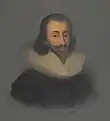
Sir John Eliot born on April 11

Francis Quarles born on May 8
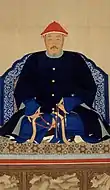
Emperor Hong Taiji born on November 28
- January 5 – Shah Jahan, 5th Mughal Emperor of India from 1628 to 1658 (d. 1666)
- January 22
- February 5 – Vincenzo della Greca, Italian architect (d. 1661)
- February 22 – Nicholas Ferrar, English trader (d. 1637)
- February 23 – Balthazar Gerbier, Dutch painter (d. 1663)
- March 20 – Giovanni da San Giovanni, Italian painter (d. 1636)
- March 28 – Comenius, Czech teacher and writer (d. 1670)[59]
- April 4 – Abraham Elzevir, Dutch printer (d. 1652)
- April 9 – Jiří Třanovský, Czech priest and musician (d. 1637)
- April 11 – John Eliot, Member of Parliament, Statesman, Vice-Admiral of Devon (d. 1632)
- April 15 – Francesco Maria Brancaccio, Catholic cardinal (d. 1675)
- April 22 – Wilhelm Schickard, German inventor (d. 1635)
- April 24
- May 8 – Francis Quarles, English poet most famous for his Emblem book aptly entitled Emblems (d. 1644)
- May 14 – Alice Barnham, wife of English scientific philosopher and statesman Francis Bacon (d. 1650)
- June 7 – Balthasar Cordier, Belgian Jesuit exegete, editor (d. 1650)
- June 9 – Jean de Brisacier, French Jesuit (d. 1668)
- June 13
- July 10 – Pierre d'Hozier, French historian (d. 1660)
- July 20 – Johan Björnsson Printz, governor of New Sweden (d. 1663)
- August 1 – François le Métel de Boisrobert, French poet (d. 1662)
- August 7 – Arnauld de Oihenart, Basque historian and poet (d. 1668)
- August 11 – Carlo de Tocco, Italian nobleman (d. 1674)
- August 13 – William, Count of Nassau-Siegen, German count (d. 1642)
- August 16 – Wybrand de Geest, Dutch painter (d. 1661)
- August 28 – George Villiers, 1st Duke of Buckingham, English statesman (d. 1628)
- August 29 – Sir Benjamin Ayloffe, 2nd Baronet, English politician (d. 1662)
- September 1 – Maria Angela Astorch, Spanish mystic and saint (d. 1665)
- September 5 – Jacopo Vignali, Italian painter (d. 1664)
- September 15 – Giovanni Battista Rinuccini, archbishop of Fermo (d. 1653)
- September 18 – Jean Guyon, French colonist (d. 1663)
- September 20 – Nicholas Stoughton, English politician (d. 1648)
- September 21 – Nathaniel Foote, American colonist (d. 1644)
- September 24 – Christopher Wandesford, English administrator and politician (d. 1640)
- September 25 – Herman Krefting, Norwegian businessman (d. 1651)
- October 7 – Henry Wenceslaus, Duke of Oels-Bernstadt, Duke of Bernstadt (1617 – 1639) (d. 1639)
- October 13 – Christian Gueintz, German teacher and writer-grammarian (d. 1650)
- October 22 – Gustav Horn, Count of Pori, Swedish/Finnish soldier and politician (d. 1657)
- October 30 – Giulio Benso, Italian painter (d. 1668)
- November 4
- November 5 – Charles Chauncy, English-born president of Harvard College (d. 1671)
- November 13 – Antonio Grassi, Italian priest (d. 1671)
- November 28 – Hong Taiji, Emperor of China (d. 1643)
- December 5 – Thomas Bennet, successful civil lawyer (d. 1670)
- December 6 – William Cavendish, 1st Duke of Newcastle (d. 1676)
- December 9 – Krzysztof Arciszewski, Polish-Lithuanian noble (d. 1656)
- December 29 – Johannes Matthiae Gothus, Swedish academic (d. 1670)
- Catalina de Erauso, Spanish-Mexican nun and soldier (d. 1650)
- Richard Bellingham, American colonial magistrate (d. 1672)
- John Hacket, English churchman (d. 1670)
- Angélique Paulet, French salonnière, singer, musician and actress (d. 1651)
- Ingen, Chinese Zen Buddhist poet, calligrapher (d. 1673)
- John Jenkins, English composer (d. 1678)
- John Oldham, early English settler in Massachusetts (d. 1636)
- Walatta Petros, saint in the Ethiopian Orthodox Tewahedo Church (d. 1642)
- Sara Copia Sullam, Italian poet and writer (d. 1641)
- Étienne Brûlé, French explorer in Canada (d. 1632)
1593
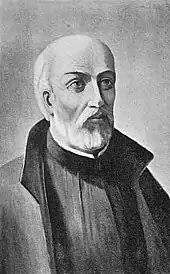
Saint Jean de Brebeuf

Catherine de' Medici, Governor of Siena
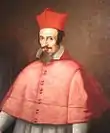
Cesare Monti
.jpg.webp)
Elisabeth of Brunswick-Wolfenbuttel, Duchess of Saxe-Altenburg
- January 1 – Sun Chuanting, Ming Dynasty general (d. 1643)
- January 10 – Prince Maurice of Savoy, Catholic cardinal and Prince of Savoy (d. 1657)
- February 8 – Louis de Nogaret de La Valette, French Catholic Cardinal (d. 1639)
- February 24 – Henry de Vere, 18th Earl of Oxford, English noble (d. 1625)
- March 1 – Franz Wilhelm von Wartenberg, German Catholic cardinal (d. 1661)
- March 13 – Georges de La Tour, French Baroque painter (d. 1652)
- March 20 – Jean de La Haye, French preacher and biblical scholar (d. 1661)
- March 22 – Johann Ulrich Steigleder, German composer (d. 1635)
- March 25 – Jean de Brébeuf, French Jesuit missionary who travelled to Canada in 1625 (d. 1649)
- April – Mumtaz Mahal, Queen of India (d. 1631)
- April 3 – George Herbert, Welsh-born English poet (d. 1633)[61]
- April 4 – Edward Nicholas, English statesman (d. 1669)
- April 12 – Nicholas Martyn, English politician (d. 1653)
- April 13 – Thomas Wentworth, 1st Earl of Strafford, English statesman (d. 1641)
- April 19 – Sir John Hobart, 2nd Baronet, English politician (d. 1647)
- April 27 – Jérôme Lalemant, French Jesuit priest and missionary to Canada (d. 1673)
- May 2
- May 5 – Cesare Monti, Italian cardinal, Archbishop of Milan (d. 1650)
- May 19
- Jacob Jordaens, Flemish painter (d. 1678)
- Claude Vignon, French painter (d. 1670)
- June 3 – Richard Knightley, English politician (d. 1639)
- June 8 – George I Rákóczi, Hungarian prince of Transylvania (d. 1648)
- June 22 – Sir John Gell, 1st Baronet, Parliamentarian politician and military figure in the English Civil War (d. 1671)
- June 23 – Elisabeth of Brunswick-Wolfenbüttel, Duchess of Saxe-Altenburg (d. 1650)
- June 24 – Abraham von Franckenberg, German writer (d. 1652)
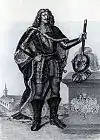
William, Margrave of Baden-Baden

Sixtinus Amama
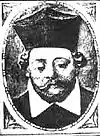
Liborius Wagner
- July 5 – Achille d'Étampes de Valençay, Knight of Malta (d. 1646)
- July 8
- Artemisia Gentileschi, Italian painter (d. 1656)[62]
- Peter Sainthill, English politician (d. 1648)
- July 20 – Henry Ernest, Count of Stolberg, then count of Stolberg-Ilsenburg (d. 1672)
- July 30 – William, Margrave of Baden-Baden (1596–1677) (d. 1677)
- August 9 – Izaak Walton, English writer (d. 1683)[63]
- August 12 – Jonathan Brewster, American settler (d. 1659)
- August 30 – Noël Juchereau, Quebec pioneer (d. 1648)
- September 5 – Orazio Riminaldi, Italian painter (d. 1630)
- September 8 – Toyotomi Hideyori, Japanese nobleman (d. 1615)
- September 20 – Gottfried Scheidt, German composer (d. 1661)
- September 22 – A. Matthäus Merian, Swiss cartographer (d. 1650)
- September 26 – Francis Osborne, English writer (d. 1659)
- October 6 – Jobst Herman, Count of Schaumburg (d. 1635)
- October 9 – Nicolaes Tulp, Dutch anatomist and politician (d. 1674)
- October 13 – Sixtinus Amama, Dutch Reformed theologian and orientalist (d. 1629)
- October 23 – Michael Warton, English politician (d. 1645)
- October 27 – Christoffer Urne, Governor General of Norway (d. 1663)
- November 1 – Abel Servien, French diplomat (d. 1659)
- November 25 – Alain de Solminihac, French bishop and beatified person (d. 1659)
- December 5 – Liborius Wagner, German Roman Catholic priest (d. 1631)
- December 11 – Sir William Airmine, 1st Baronet, English politician (d. 1651)
- December 12
- Leonardo Agostini, Italian antiquary (d. 1685)
- Louis Barbier, French bishop (d. 1670)
- Francis Russell, 4th Earl of Bedford (d. 1641)
- Claudia Rusca, Italian composer, singer, and organist (d. 1676)
- Mervyn Tuchet, 2nd Earl of Castlehaven (d. 1631)
- Anthony van Diemen, Dutch merchant (d. 1645)
- Jerónimo Lobo, Portuguese Jesuit missionary (d. 1678)
- Mikołaj Ostroróg, Polish nobleman (d. 1651)
- Sir George Radcliffe, English politician (d. 1657)
- Kimura Shigenari, Japanese samurai (d. 1615)
- Giovanni Battista Pacetti, Italian painter (d. 1630)
1594
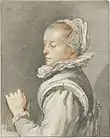
Maria Tesselschade Visscher
- January 1 – Barthélemy Vimont, French missionary (d. 1667)
- January 7 – Vincenzo II Gonzaga, Duke of Mantua, Italian duke and Catholic cardinal (d. 1627)
- January 12 – Gregers Krabbe, Governor-general of Norway (d. 1655)
- January 16 – Maeda Toshitsune, Japanese warlord (d. 1658)
- January 24 – Pierre de Marca, French bishop and historian (d. 1662)
- February 2 – Philip Powell, Welsh martyr (d. 1646)
- February 5 – Biagio Marini, Italian violinist and composer (d. 1663)
- February 16 – Juliana Morell, Spanish-French scholar (d. 1653)
- February 19 – Henry Frederick, Prince of Wales, elder son of King James I & VI and Anne of Denmark (d. 1612)[64]
- February 21 – John Ernest I, Duke of Saxe-Weimar, German duke (d. 1626)
- February 26 – William Wadsworth, American colonial (d. 1675)
- March 25 – Maria Tesselschade Visscher, Dutch poet and engraver (d. 1649)
- April 21 – Bernardino Spada, Italian Catholic cardinal (d. 1661)
- April 29 – Samuel Fairclough, English minister (d. 1677)
- May 1 – John Haynes, governor of Connecticut (d. 1653)
- May 9 – Louis Henry, Prince of Nassau-Dillenburg, military leader in the Thirty Years' War (d. 1662)
- May 15 – Sophie of Solms-Laubach, wife of Joachim Ernst, Margrave of Brandenburg-Ansbach (d. 1651)
- May 29 – Gottfried Heinrich Graf zu Pappenheim, field marshal of the Holy Roman Empire in the Thirty Years' War (d. 1632)
- June 3 – César, Duke of Vendôme, French nobleman (d. 1665)
- June 11 – Thomas Cromwell, 1st Earl of Ardglass, English nobleman (d. 1653)
- June 23 – Thomas Tyrrell, English judge and politician (d. 1672)
- June – Nicolas Poussin, French painter (d. 1665)
- July 6 – Frederick V, Margrave of Baden-Durlach (1622–1659) (d. 1659)
- July 10 – Bartolomeo Gennari, Italian painter (d. 1661)
- July 14 – Beat Albrecht von Ramstein, German Catholic bishop (d. 1651)
- August 4 – Aleksander Ludwik Radziwiłł, Polish noble (d. 1654)
- August 5 – Stefano Durazzo, Italian cardinal (d. 1667)
- August 16 – Queen Inyeol, Korean royal consort (d. 1636)
- September 13 – Francesco Manelli, Italian composer (d. 1667)
- September 30 – Antoine Girard de Saint-Amant, French poet (d. 1661)
- October 4 – Johan Schatter, Dutch Golden Age member of the Haarlem schutterij (d. 1673)
- October 27 – Johann Rudolf Wettstein, Swiss diplomat (d. 1666)
- November 15 – Jean Puget de la Serre, French author and dramatist (d. 1665)
- November 24 – Henry Grey, 10th Earl of Kent (d. 1651)
- November 26 – James Ware, Irish genealogist (d. 1666)
- November 30 – John Cosin, English churchman (d. 1672)
- December 7 – Frederik Coning, Dutch Golden Age member of the Haarlem schutterij (d. 1636)
- December 8 – Pierre Petit, French astronomer, military engineer, and physicist (d. 1677)
- December 9 – King Gustavus Adolphus of Sweden, Swedish king and general (d. 1632)
- December 21 – Robert Sutton, 1st Baron Lexinton, English politician (d. 1668)
- December 24 – Otto, Landgrave of Hesse-Kassel, Prince of Hesse-Kassel, Administrator of Hersfeld Abbey (d. 1617)
- December 27 – Ove Gjedde, Danish admiral, member of the interim government after the death of Christian IV (d. 1660)
- John Bramhall, English Anglican clergyman and controversialist (d. 1663)
- Peter Oliver, English miniaturist (d. 1648)
- Tomasz Zamoyski, Polish nobleman (d. 1638)
- Tarquinio Merula, Italian composer (d. 1665)
1595
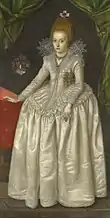
Hedwig of Brunswick-Wolfenbüttel

Jan Marek Marci
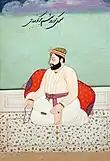
Guru Hargobind

Albrycht Stanisław Radziwiłł
- January 15 – Henry Carey, 2nd Earl of Monmouth, English politician (d. 1661)
- January 22 – George Rudolf of Liegnitz, Polish noble (d. 1653)
- January 23 – Herman Fortunatus, Margrave of Baden-Rodemachern (d. 1665)
- February 9 – Hedwig of Brunswick-Wolfenbüttel, Duchess consort of Pomerania (d. 1650)
- March 19 – Carlo de' Medici, Italian Catholic cardinal (d. 1666)
- March 21 – Ferdinando Ughelli, Italian Cistercian monk and church historian (d. 1670)
- March 23 – Bevil Grenville, English royalist soldier (d. 1643)
- April 5 – John Wilson, English composer (d. 1674)
- April 6
- April 12 – Miles Hobart, English politician (d. 1632)
- April 30
- May 1 – Lars Kagg, Swedish count and military Officer (d. 1661)
- May 3 – Aloysius Gottifredi, Italian Jesuit (d. 1652)
- June 9 – King Wladislaus IV of Poland (d. 1648)[65]
- June 10 – Aegidius Gelenius, German heraldist (d. 1656)
- June 13
- June 19 – Guru Har Gobind, the Sixth Sikh Guru (d. 1644)
- June 24 – Ulderico Carpegna, Italian Catholic cardinal (d. 1679)
- July 1 – Albrycht Stanisław Radziwiłł, Polish nobleman (d. 1656)
- July 3 – John Gurdon, English politician (d. 1679)
- July 4 – Félix Castello, Spanish artist (d. 1651)
- July 9 – Anna Amalia of Baden-Durlach, Regent of Nassau-Saarbrücken (d. 1651)
- July 10 – Charles Drelincourt, French Protestant divine (d. 1669)
- July 31 – Philipp Wolfgang, Count of Hanau-Lichtenberg (d. 1641)
- August 29 – Joachim Ernest, Duke of Schleswig-Holstein-Sonderburg-Plön (1622–1671) (d. 1671)
- August 31 – Georges Fournier, French Jesuit mathematician and geographer (d. 1652)
- October 18 – Lucas van Uden, Dutch painter (d. 1672)
- October 30 – Gaj Singh of Marwar, Raja of Marwar Kingdom (r (d. 1638)
- November 11 – Martin Bauzer, Gorizian Jesuit priest and writer (d. 1668)
- November 13 – George William, Elector of Brandenburg (d. 1640)
- November 18
- December 1 – Robert Sidney, 2nd Earl of Leicester, English politician (d. 1677)
- December 3 – Henry Ley, 2nd Earl of Marlborough, English politician (d. 1638)
- December 4 – Jean Chapelain, French poet and critic during the Grand Siècle (d. 1674)
- December 5 – Henry Lawes, English musician and composer (d. 1662)
- December 7 – Injo of Joseon, sixteenth king of the Joseon dynasty in Korea (d. 1649)
- December 11 – Heo Mok, Korean politician, poet and scholar (d. 1682)
- December 14 – Arthur Wilson, English writer (d. 1652)
- December 27 – Bohdan Khmelnytsky, hetman of Ukraine (d. 1657)
- Thomas Carew, English poet (d. 1645)
- Miles Corbet, English Puritan politician (d. 1662)
- Jean Desmarets, French writer (d. 1676)
- Henry Herbert, English official (d. 1673)
- Lars Kagg, Swedish soldier and politician (d. 1661)
- Thomas May, English poet and historian (d. 1650)
- Bartholomaeus Nigrinus, Polish Rosicrucian (d. 1646)
- Pocahontas, Algonquian princess (d. 1617)
- Mikołaj Potocki, Polish politician (d. 1651)
- Robert Sempill the younger, Scottish writer (d. 1663)
- Cornelius Vermuyden, Dutch engineer (d. 1683)
- Dirck van Baburen, Dutch painter (d. 1624)
- Albrycht Stanisław Radziwiłł, Lithuanian chancellor (d. 1656)
1596
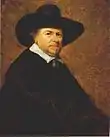
Jan van Goyen

Emperor Go-Mizunoo
- January 1 – Elizabeth Ribbing, Swedish noble (d. 1662)
- January 13 – Jan van Goyen, Dutch painter (d. 1656)
- February 2
- February 3 – Brás Garcia de Mascarenhas, soldier, poet and writer (d. 1656)
- February 8 – Louis Giry, French lawyer, classical scholar (d. 1665)
- February 27 – Johan Stiernhöök, Swedish lawyer (d. 1675)
- March 1 – Duke Frederick of Saxe-Weimar, German prince and colonel (d. 1622)
- March 10 – Princess Maria Elizabeth of Sweden (d. 1618)
- March 11 – Isaac Elzevir, Dutch printer and publisher (d. 1651)
- March 16 – Ebba Brahe, Swedish countess (d. 1674)
- March 24 – Elizabeth of Hesse-Kassel, Duchess of Mecklenburg-Gütsrow (d. 1625)
- March 26 – Catherine Henriette de Bourbon, French noble (d. 1663)
- March 31 – René Descartes, French philosopher and mathematician (d. 1650)[66]
- April 8 – Juan van der Hamen, Spanish artist (d. 1631)
- April 11 – Moritz Gudenus, German Catholic preacher (d. 1680)
- May 9 – Abraham van Diepenbeeck, Dutch painter (d. 1675)
- May 21 – John Louis II, Count of Nassau-Wiesbaden-Idstein (d. 1605)
- June 5 – Peter Wtewael, Dutch painter (d. 1660)
- June 6 – Michel Particelli d'Emery, French politician (d. 1650)
- June 23 – Johan Banér, Swedish field marshal in the Thirty Years' War (d. 1641)
- June 27 – Maximilian, Prince of Dietrichstein, German prince (d. 1655)
- June 29 – Emperor Go-Mizunoo of Japan (d. 1680)
- July 1 – Bertuccio Valiero, Doge of Venice (d. 1658)
- July 12 – Michael I of Russia, Russian Tsar (d. 1645)[67]
- August 10 – Lorentz Eichstadt, German mathematician and astronomer (d. 1660)
- August 26 – Frederick V, Elector Palatine (d. 1632)
- August 18 – Jean Bolland, Belgian Jesuit, Founder of the Bollandist (d. 1665)
- August 19 – Elizabeth Stuart, later Queen of Bohemia (d. 1662)[68]
- September
- September 3 – Nicola Amati, Italian luthier from Cremona (d. 1684)
- September 4 – Constantijn Huygens, Dutch Golden Age poet and composer (d. 1687)[69]
- September 7 – John Casimir, Prince of Anhalt-Dessau (d. 1660)
- September 11 – Francis Eaton, Mayflower passenger and New World colonist (d. 1633)
- September 23 – Joan Blaeu, Dutch cartographer (d. 1673)
- October 1 – Cesare Dandini, Italian painter (d. 1657)
- October 5 – Pieter van Mierevelt, Dutch painter (d. 1623)
- October 18 – Edward Winslow, American Pilgrim leader (d. 1655)
- October 23 – Daniel Hay du Chastelet de Chambon, French mathematician (d. 1671)
- October 26 – Robert Coe, American colonial (d. 1689)
- November 1
- Albert, Count of Nassau-Dillenburg, joint ruler of Nassau-Dillenburg 1623–1626 (d. 1626)
- Pietro da Cortona, Italian painter (d. 1669)
- November 5 – Charles II, Duke of Elbeuf, French noble (d. 1657)
- November 6 – Jeanne Chezard de Matel, French mystic (d. 1670)
- November 21 – René de Voyer de Paulmy d'Argenson, French politician (d. 1651)
- December 12 – Sir Edward Osborne, 1st Baronet, English politician (d. 1647)
- December 13 – António Luís de Meneses, 1st Marquis of Marialva, Portuguese general and noble (d. 1675)
- December 21
- December 24 – Leonaert Bramer, Dutch painter (d. 1674)
- Francesco Buonamici, Italian architect, painter and engraver (d. 1677)[70]
- John Dury, Scottish-born Calvinist minister (d. 1680)
- Franz von Hatzfeld, Prince-Bishop of Würzburg (d. 1642)
- Lucas Holstenius, German humanist (d. 1661)
- Georg Jenatsch, Swiss political leader (d. 1639)
- Richard Mather, American clergyman (d. 1669)
- Horio Tadaharu, Japanese warlord (d. 1633)
1597
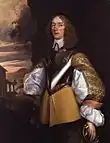
Henry Gage
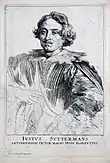
Justus Sustermans
- January 12 – François Duquesnoy, Flemish Baroque sculptor in Rome (d. 1643)
- January 25 – Johann Philipp, Duke of Saxe-Altenburg, German Duke (d. 1639)
- January 31 – John Francis Regis, French Jesuit priest (d. 1640)
- February 24 – Vincent Voiture, French poet (d. 1648)[71]
- March 1 – Jean-Charles de la Faille, Belgian mathematician (d. 1652)
- March 10 – Ercole Gennari, Italian drawer and painter (d. 1658)
- March 18 – Jérôme le Royer de la Dauversière, French nobleman, founder of Montreal and an order of nursing Sisters (d. 1659)
- March 21 – Juan Alonso y Ocón, Spanish Catholic prelate, Archbishop of La Plata o Charcas (d. 1656)
- March 27 – William Hyde, President of English College, Douai (d. 1651)
- April 9 – John Davenport, English Puritan clergyman, co-founder of the American colony of New Haven (d. 1670)
- April 13 – Giovanni Battista Hodierna, Italian astronomer (d. 1660)
- April 23 – Alvise Contarini, Italian diplomat, nobleman (d. 1651)
- May 13 – Cornelis Schut, Flemish painter, draughtsman and engraver (d. 1655)
- May 15 – Squire Bence, English politician (d. 1648)
- May 25 – Veit Erbermann, German theologian (d. 1675)
- May 31 – Jean-Louis Guez de Balzac, French author (d. 1654)
- June 9 – Pieter Jansz. Saenredam, Dutch painter (d. 1665)
- July 2 – Theodoor Rombouts, Flemish painter (d. 1637)
- July 13 – Sebastian Stoskopff, French painter (d. 1657)
- July 22 – Virgilio Mazzocchi, Italian Baroque composer (d. 1646)
- July 29 – Abdias Treu, German mathematician and academic (d. 1669)
- August 20
- August 21 – Roger Twysden, English antiquarian and royalist (d. 1672)
- August 29 – Henry Gage, Royalist officer in the English Civil War (d. 1645)
- September 23 – Francesco Barberini, Italian Catholic cardinal (d. 1679)
- September 28 – Justus Sustermans, Flemish painter (d. 1681)
- October 7 – Captain John Underhill, English settler and soldier (d. 1672)
- October 13 – Otto Louis of Salm-Kyrburg-Mörchingen, Swedish general in the Thirty Years' War (d. 1634)
- October 20 – Matthew Hutton, English politician (d. 1666)
- November 15 – Juan Tellez-Girón y Enriquez de Ribera, 4th Duke of Osuna (d. 1656)
- November 19 – Elizabeth Charlotte of the Palatinate, wife of George William (d. 1660)
- December 16
- December 22 – Frederick III, Duke of Holstein-Gottorp (d. 1659)
- December 23
- Martin Opitz, German poet (d. 1639)
- December 24 – Honoré II, Prince of Monaco (d. 1662)
- Cristóbal Diatristán de Acuña, Spanish missionary and explorer (d. 1676)
- Johan van Heemskerk, Dutch poet (d. 1656)
- Cornelis Jol, Dutch naval commander and privateer (d. 1641)
- Wang Wei, Chinese poet (d. 1647)
1598
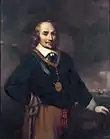
Maarten Tromp
- January 23 – François Mansart, French architect (d. 1666)
- March 12 – Guillaume Colletet, French writer (d. 1659)
- March 13 – Johannes Loccenius, German historian (d. 1677)
- March 15 – Redemptus of the Cross, Portuguese Carmelite lay brother and martyr (d. 1638)
- March 25
- March 26 – Sir William Lewis, 1st Baronet, English politician (d. 1677)
- April 9 – Johann Crüger, German composer of well-known hymns (d. 1662)
- April 11 – William, Duke of Saxe-Weimar, German nobleman (d. 1662)
- April 17 – Giovanni Battista Riccioli, Italian astronomer (d. 1671)
- April 23 – Maarten Tromp, officer and later admiral in the Dutch navy (d. 1653)
- April 28 – Francis Leigh, 1st Earl of Chichester, English politician (d. 1653)
- May 23 – Claude Mellan, French painter and engraver (d. 1688)
- June 4 – Åke Henriksson Tott, Swedish soldier and politician (d. 1640)
- June 19 – Gilbert Sheldon, Archbishop of Canterbury from 1663 until his death (d. 1677)
- July 6 – Kirsten Munk, Danish noble, spouse of King Christian IV of Denmark (d. 1658)
- July 29 – Henricus Regius, Dutch philosopher (d. 1679)
- July 31 – Alessandro Algardi, Italian high-Baroque sculptor active in Rome (d. 1654)
- August 7 – Georg Stiernhielm, Swedish civil servant (d. 1672)
- September 11 – Imre Thurzó, Hungarian noble (d. 1621)
- September 23 – Eleonora Gonzaga, Holy Roman Empress, married to Ferdinand II, Holy Roman Emperor (d. 1655)
- September 24 – Giovanni Francesco Busenello, Italian librettist (d. 1659)
- September 27 – Robert Blake, English admiral (d. 1657)
- October 14 – Nicolas de Neufville de Villeroy, Marshal of France (d. 1685)
- October 17 – Jørgen Knudsen Urne, Danish noble (d. 1642)
- October 19 – Isaac Commelin, Dutch historian (d. 1676)
- October 27 – Lars Stigzelius, Swedish Lutheran archbishop (d. 1676)
- November 3 – Christian I, Count Palatine of Birkenfeld-Bischweiler (1600–1654) (d. 1654)
- November 4 – Ernst Adalbert von Harrach, Austrian Catholic cardinal (d. 1667)
- November 7 – Francisco de Zurbarán, Spanish painter (d. 1664)
- November 28 – Hans Nansen, Danish statesman (d. 1667)
- December 7 – Gian Lorenzo Bernini, Italian sculptor (d. 1680)[72]
- December 20 – Ottavio Farnese, Italian noble (d. 1643)
- December 22 – Henri de La Trémoille, French general and noble (d. 1674)
- December 24 – Margaret Stuart, Scottish princess (d. 1600)
- Bonaventura Cavalieri, Italian mathematician (d. 1647)
- Marmaduke Langdale, Royalist in the English Civil War (d. 1661)
- Baldassarre Longhena, Venetian architect (d. 1682)[73]
- Jean Nicolet, French explorer (d. 1642)
- William Strode, English parliamentarian (d. 1645)[74]
- Guðríður Símonardóttir, Icelandic woman known as a victim of the Turkish abductions (d. 1682)
- probable
- Jean-Armand du Peyrer, Comte de Tréville and French officer (d. 1672)
- Mary Bankes, Royalist in the English Civil War, defender of Corfe Castle (d. 1661)
1599

Saint John Berchmans
- January 22 – Robert Petre, 3rd Baron Petre, English baron (d. 1638)
- January 31 – Juraj V Zrinski, Ban of Croatia (d. 1626)
- February 12
- February 13 – Pope Alexander VII (d. 1667)[75]
- March 1 – John Mennes, English Royal Navy admiral (d. 1671)
- March 3 – Juan Alfonso Enríquez de Cabrera, Viceroy of Sicily and Viceroy of Naples (d. 1647)
- March 13 – John Berchmans, Belgian Jesuit scholastic and saint (d. 1621)
- March 22 – Anthony van Dyck, Flemish painter (d. 1641)[76]
- March 23 – Thomas Selle, German baroque composer (d. 1663)
- March 28 – Witte de With, famous Dutch naval officer of the 17th century (d. 1658)
- April 9 – Sir Thomas Mauleverer, 1st Baronet (d. 1655)
- April 17 – Patrick Fleming, Irish Franciscan friar and scholar (murdered) (d. 1631)
- April 25 – Oliver Cromwell, Lord Protector of England, Scotland, and Ireland (d. 1658)[77]
- May 16 – Nicolaes Olycan, Dutch businessman (d. 1639)
- May 30 – Samuel Bochart, French Protestant biblical scholar (d. 1667)
- June 1 – Elizabeth Lucretia, Duchess of Cieszyn, Duchess suo jure of Cieszyn (d. 1653)
- June 6 – Diego Velázquez, Spanish painter (d. 1660)
- July 23 – Stephanius, Danish historian (d. 1650)
- July 27 – Albert IV, Duke of Saxe-Eisenach (1640–1644) (d. 1644)
- August 11 – Christian II, Prince of Anhalt-Bernburg (1630–1656) (d. 1656)
- August 13 – Johannes Buxtorf II, Swiss theologian (d. 1664)
- August 14 – Méric Casaubon, English classicist (d. 1671)
- August 16 – Diego López Pacheco, 7th Duke of Escalona, Spanish noble (d. 1653)
- August 22 – Agatha Marie of Hanau, German noblewoman (d. 1636)
- September 7 – Jacob Westerbaen, Dutch poet (d. 1670)
- September 20 – Christian, Duke of Brunswick-Lüneburg-Wolfenbüttel, German Protestant military leader (d. 1626)
- September 24 – Adam Olearius, German scholar (d. 1671)
- September 25 – Francesco Borromini, Swiss sculptor and architect (d. 1667)
- September 30 – Frances Seymour, Duchess of Somerset (d. 1674)
- October 10
- October 11 – Abraham de Fabert, Marshal of France (d. 1662)
- October 15 – Cornelis de Graeff, Dutch mayor (d. 1664)
- October 28 – Marie of the Incarnation, French foundress of the Ursuline Monastery in Quebec (d. 1672)
- October 31 – Denzil Holles, 1st Baron Holles, English statesman and writer (d. 1680)
- November 5 – Carlo Emanuele Madruzzo, Italian prince-bishop (d. 1658)
- November 11
- November 13 – Otto Christoph von Sparr, German general (d. 1668)
- November 15 – Werner Rolfinck, German physician, chemist, botanist and philosopher (d. 1673)
- November 29 – Peter Heylin, English ecclesiastic and author of many polemical works (d. 1662)
- November 30 – Andrea Sacchi, Italian painter of High Baroque Classicism (d. 1661)
- December 2
- December 11 – Pieter Codde, Dutch painter (d. 1678)
- December 14 – Charles Berkeley, 2nd Viscount Fitzhardinge, English politician (d. 1668)
- December 16 – Jacques Vallée, Sieur Des Barreaux, French poet (d. 1673)
- December 20 – Niels Trolle, Governor General of Norway (d. 1667)
- December 29 – Gabriel Bucelin, German historian (d. 1681)
- John Alden, English settler of Plymouth Colony (d. 1687)
- Stefan Czarniecki, Polish military commander (d. 1665)
- Lucy Hay, Countess of Carlisle, English courtier (d. 1660)
- Charlotte Stanley, Countess of Derby defender of Latham House (d. 1664)
- Jirgalang, Qing Dynasty prince (d. 1655)
Deaths
1590

Saint Catherine de Ricci
- January 7 – Jakob Andreae, German theologian (b. 1528)
- January 20 – Giambattista Benedetti, Italian mathematician and physicist (b. 1530)
- February 1 – Lawrence Humphrey, president of Magdalen College, Oxford (b. 1527)
- February 2 – Catherine of Ricci, Catholic prioress and saint (b. 1522)
- February 4 – Gioseffo Zarlino, Italian music theorist and composer (b. 1517)
- February 12
- February 18 – Asahi no kata, Japanese lady, Toyotomi Hideyoshi's half-sister (b. 1543)
- February 19 – Philipp IV, Count of Hanau-Lichtenberg (b. 1514)
- February 21 – Ambrose Dudley, 3rd Earl of Warwick, English nobleman and general (b. 1528)
- March 4 – Duchess Hedwig of Württemberg, by marriage countess of Hesse-Marburg (b. 1547)
- April 2 – Elisabeth of Saxony, Countess Palatine of Simmern (b. 1552)
- April 6 – Francis Walsingham, English spymaster (b. 1530)[78]
- May 9 – Charles de Bourbon French cardinal and pretender to the throne (b. 1523)
- June 28 – Hori Hidemasa, Japanese warlord (b. 1553)
- June 30 – Maha Thammaracha (b. 1509)
- July 10 – Charles II, Archduke of Austria, regent of Inner Austria (b. 1540)
- July 21 – Sophie of Württemberg, German noble (b. 1563)
- August 10
- August 17 – James III, Margrave of Baden-Hachberg (b. 1562)
- August 27 – Pope Sixtus V (b. 1521)[79]
- September 10 – Archduchess Magdalena of Austria, Member of the House of Habsburg (b. 1532)
- September 13 – Pedro Téllez-Girón, 1st Duke of Osuna, Spanish duke (b. 1537)
- September 20 – Lodovico Agostini, Italian composer (b. 1534)
- September 27 – Pope Urban VII (b. 1521)[3]
- October 4 – Jacques Cujas, French legal expert (b. 1522)[80]
- October 12 – Kanō Eitoku, Japanese painter (b. 1543)[81]
- October 16 – Archduchess Anna of Austria, Duchess of Bavaria (b. 1528)
- October 18 – Philip, Duke of Holstein-Gottorp (b. 1570)
- October 23 – Bernardino de Sahagún, Franciscan missionary (b. 1499)
- October 29 – Dirck Volckertszoon Coornhert, Dutch politician and theologian (b. 1522)
- November 18 – George Talbot, 6th Earl of Shrewsbury, English statesman (b. 1528)
- November 19 – Girolamo Zanchi, Italian theologian (b. 1516)
- November 29 – Philipp Nicodemus Frischlin, German philologist and poet (b. 1547)
- December 20 – Ambroise Paré, French surgeon (b. 1510)
- December 27 – Emanuel Philibert de Lalaing, Belgian noble and army commander (b. 1557)
- Nicholas Bobadilla, one of the first Spanish Jesuits (b. 1511)
- Marietta Robusti, Venetian Renaissance painter (b. 1555 or 1560)
- Roger Dudley, British soldier (b. 1535)
- Sorley Boy MacDonnell, Irish chieftain (b. 1505)
- Juan Bautista de Pomar, Spanish colonial historian and writer
- Catherine Salvaresso, Wallachian regent
- Maddalena Casulana, Italian composer, lutenist and singer (d. 1544)
Bernard Palissy, French potter (b. 1510) 1591
- February 6 – Anna Sophia of Prussia, Duchess of Prussia and Duchess of Mecklenburg (b. 1527)
- February 26 – Vespasiano I Gonzaga, Italian noble and diplomat (b. 1531)
- March 17 – Jost Amman, Swiss printmaker (b. 1539)
- April 9 – Emilie of Saxony, German noble (b. 1516)
- April 21 – Sen no Rikyū, Japanese exponent of the tea ceremony (b. 1522)
- May 19 – Elizabeth Cecil, 16th Baroness de Ros, English noblewoman (b. c. 1574)
- May 15 – Tsarevich Dimitri, of Russia (b. 1582)
- June 21 – Aloysius Gonzaga, Italian Jesuit and saint (b. 1568)
- July 2 – Vincenzo Galilei, Italian composer (b. 1520)
- July 10 – Anna of Hesse, Countess Palatine of Zweibrücken (b. 1529)
- July 18 – Jacobus Gallus Carniolus, Slovenian composer (b. 1550)
- August 23 – Luis Ponce de León, Spanish lyric poet (b. 1527)
- August 27 – Katheryn of Berain, Welsh noblewoman (b. 1534)[82]
- September 7 – Heinrich Sudermann, German politician (b. 1520)
- September 10 – Richard Grenville, English soldier and explorer (b. 1542)
- September 19 – Alonso de Orozco Mena, Spanish Catholic priest (b. 1500)
- September 25 – Christian I, Elector of Saxony (b. 1560)
- September 29 – Count Johan II of East Frisia (b. 1538)
- October 15 – Duke Otto Henry of Brunswick-Harburg, Hereditary Prince of Brunswick-Lüneburg-Harburg (b. 1555)
- October 16 – Pope Gregory XIV (b. 1535)[83]
- November 20 – Christopher Hatton, English politician (b. 1540)
- December 14 – Saint John of the Cross, Spanish Carmelite friar and poet (b. 1542)
- December 18 – Marigje Arriens, Dutch woman executed for witchcraft (b. c. 1520)
- December 30 – Pope Innocent IX (b. 1519)[84]
- Ananias Dare, father of Virginia Dare, (b. circa 1560)
- Virginia Dare, first English child born in America, (b. 1587) (Unverified)
- Crispin van den Broeck, Flemish painter (b. 1523)
- John Erskine of Dun, Scottish religious reformer (b. 1509)
- Toyotomi Hidenaga, Japanese nobleman (b. 1540)
- John Stubbs, English pamphleteer (b. 1543)
- Veronica Franco, Italian poet and courtesan (b. 1546)
1592
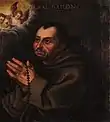
Saint Paschal Baylon died on May 17, 1592

King John III of Sweden died on November 17, 1592
- January 5 – William, Duke of Jülich-Cleves-Berg, German nobleman (b. 1516)
- January 22 – Elisabeth of Austria, Queen of France (b. 1554)
- January 27 – Gian Paolo Lomazzo, Italian painter (b. 1538)
- February 2 – Ana de Mendoza, Princess of Eboli, Spanish noble (b. 1540)
- February 29 – Alessandro Striggio, Italian composer (b. 1540)
- March 4 – Christopher, Duke of Mecklenburg and administrator of Ratzeburg (b. 1537)
- March 5 – Michiel Coxie, Flemish painter (b. 1499)
- March 22 – Johann VII, Duke of Mecklenburg, Duke of Mecklenburg-Schwerin (1576–1592) (b. 1558)
- April 8 – Dorothea Susanne of Simmern, Duchess of Saxe-Weimar (b. 1544)
- April 13 – Bartolomeo Ammannati, Italian architect and sculptor (b. 1511)
- April 18 – George John I, Count Palatine of Veldenz (b. 1543)
- April 21 – Christoph, Count of Hohenzollern-Haigerloch (b. 1552)
- May 17 – Paschal Baylon, Spanish mystic and saint (b. 1540)
- May 24 – Nikolaus Selnecker, German musician (b. 1530)
- June 17 – Ernst Ludwig, Duke of Pomerania (b. 1545)
- July 1 – Marc'Antonio Ingegneri, Italian composer (b. c. 1547)
- July 4 – Francesco Bassano the Younger, Italian painter (b. 1559)
- July 6 – John George of Ohlau, Duke of Oława and Wołów (1586-1592) (b. 1552)
- July 18 – Sibylle of Saxony, Duchess of Saxe-Lauenburg (b. 1515)
- July 22 – Ludwig Rabus, German martyrologist (b. 1523)
- July 26 – Armand de Gontaut, baron de Biron, French soldier (b. 1524)
- August 20 – William the Younger, Duke of Brunswick-Lüneburg (b. 1535)
- August 25
- September 3 – Robert Greene, English writer (b. 1558)
- September 13 – Michel de Montaigne, French essayist (b. 1533)[85]
- September 20 – Francisco Vallés, Spanish physician (b. 1524)
- October 15 – Jean Vendeville, law professor, Roman Catholic bishop (b. 1527)
- October 19 – Anthony Browne, 1st Viscount Montagu, English politician (b. 1528)
- October 28 – Ogier Ghiselin de Busbecq, Flemish diplomat (b. 1522)
- November 17 – King John III of Sweden (b. 1537)[86]
- November 27 – Nakagawa Hidemasa, Japanese military commander (b. 1568)
- December 3 – Alexander Farnese, Duke of Parma (b. 1545)
- Date unknown
1593
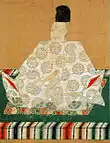
Emperor Ogimachi

The Marlowe portrait, often claimed to be Christopher Marlowe, playwright
- January 8 – Mingyi Swa, Burmese crown prince (b. 1558)
- January 11 – Scipione Gonzaga, Italian Catholic cardinal (b. 1542)
- February 6
- March 8 – Paul Luther, German scientist (b. 1533)
- March 23 – Henry Barrowe, English Puritan and separatist (b. 1550)
- April 6 – John Greenwood, English Puritan and separatist (hanged) (b. 1556)
- April 24 – William Harrison, English clergyman (b. 1534)
- May 29 – John Penry, Welsh Protestant (hanged) (b. 1559)[87]
- May 30 – Christopher Marlowe, English poet and playwright (murdered) (b. 1564)[88]
- June 3 – Katarina Bengtsdotter Gylta, Swedish abbess (b. 1520)
- June 25 – Michele Mercati, Italian physician and botanist (b. 1541)
- July 4 – Min Phalaung, Burmese monarch (b. 1535)
- July 11 – Giuseppe Arcimboldo, Italian painter (b. 1527)
- September 5 – Andreas von Auersperg, Carniolan noble and military commander in the battle of Sisak (b. 1556)
- September 25 – Henry Stanley, 4th Earl of Derby, English nobleman, diplomat and politician (b. 1531)
- October 25 – Gómez Pérez Dasmariñas, Spanish colonial administrator (murdered) (b. 1519)
- November 11 – Albert, Count of Nassau-Weilburg (b. 1537)
- November 20 – Hans Bol, Flemish artist (b. 1534)
- date unknown
1594
- February – Barnabe Googe, English poet (b. 1540)
- February 2 – Giovanni Pierluigi da Palestrina, Italian composer (b. 1525)[89]
- February 8 – Countess Palatine Elisabeth of Simmern-Sponheim, Duchess of Saxony (b. 1540)
- April 16 – Ferdinando Stanley, 5th Earl of Derby (b. 1559), second in line to the throne of England[90]
- April 29 – Thomas Cooper, English bishop, lexicographer, and writer (b. c. 1517)
- May 2 – Edward Atslowe, English physician
- May 15 – Charlotte de La Marck, French duchess (b. 1574)
- May 30 – Bálint Balassi, Hungarian writer and noble (b. 1554)
- May 31
- Tintoretto, Italian painter (b. 1518)[91]
- Francesco Panigarola, Italian bishop (b. 1548)
- June 3 – John Aylmer, English divine (b. 1521)
- June 7 – Rodrigo Lopez, Queen Elizabeth's physician (executed for treason) (b. 1525)
- June 14 – Orlande de Lassus, Flemish composer (b. 1532)[92]
- June 29 – Niels Kaas, Danish chancellor (b. 1535)
- July – Girolamo Mei, Italian historian and humanist (b. 1519)
- July 10 – Paolo Bellasio, Italian composer and organist (b. 1554)
- August 5 – Archduchess Eleanor of Austria (b. 1534)
- October 8 – Ishikawa Goemon, Japanese ninja and thief (b. 1558)
- October 16 – William Allen, English cardinal (b. 1532)
- November 15 – Sir Martin Frobisher, British explorer (b. 1535)[93]
- November 20 – Gaspar de Quiroga y Vela, General Inquisitor of Spain (b. 1512)
- November 29 – Alonso de Ercilla y Zúñiga, Basque soldier and poet (b. 1533)
- December 2 – Gerardus Mercator, Flemish-German cartographer (b. 1512)
- December 16 – Allison Balfour, alleged Scottish witch
- date unknown
1595

Saint Philip Neri
_c_1580.jpg.webp)
Magnus, Duke of Östergötland
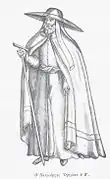
Patriarch Jeremias II of Constantinople
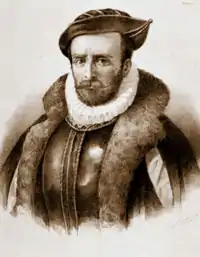
Álvaro de Mendaña de Neira
- January 2 – Barbara of Brandenburg, Duchess of Brieg, German princess (b. 1527)
- January 15 – Murad III, Ottoman Sultan (b. 1546)
- January 24 – Ferdinand II, Archduke of Austria, regent of Tyrol and Further Austria (b. 1529)
- February – William Painter, English translator (b. 1540)
- February 20 – Archduke Ernest of Austria, Governor of the Spanish Netherlands (b. 1553)
- February 21 – Robert Southwell, Jesuit priest and poet (b. 1561)
- April 25 – Torquato Tasso, Italian poet (b. 1544)[94]
- May 4 – Hugues Loubenx de Verdalle, Cardinal and 52nd Grandmaster of the Knights Hospitaller (b. 1531)
- May 14 – Wolfgang, Duke of Brunswick-Grubenhagen (b. 1531)
- May 19 – John Frederick II, Duke of Saxony (b. 1529)
- May 25
- Valens Acidalius, German critic and poet (b. 1567)
- Philip Neri, Italian Roman Catholic priest and saint (b. 1515)[95]
- June 23 – Louis Carrion, Flemish humanist and classical scholar (b. 1547)
- June 26 – Magnus, Duke of Östergötland, Swedish prince (b. 1542)
- July 10 – Udai Singh of Marwar, Ruler of Marwar (b. 1538)
- July 23 – Thoinot Arbeau, French priest and author (b. 1519)
- August 24 – Thomas Digges, English astronomer (b. 1546)
- August 26 – Antonio, Prior of Crato, claimant to the throne of Portugal (b. 1531)
- September 3 – Philip of Nassau, Count of Nassau (b. 1566)
- September 4 – Jeremias II of Constantinople (b. 1530)
- October 15 – Faizi, Indo-Persian poet and scholar (b. 1547)
- October 18 – Álvaro de Mendaña de Neira, Spanish navigator and explorer (b. 1542)
- October 19 – Philip Howard, 20th Earl of Arundel, English nobleman (b. 1537)
- October 23 – Louis Gonzaga, Duke of Nevers, Italian-French dignitary and diplomat (b. 1539)
- November 4 – Francesco Cattani da Diacceto, Bishop of Fiesole (b. 1531)
- November 5 – Luis Barahona de Soto, Spanish poet (b. 1548)
- November 12 – John Hawkins, English shipbuilder and trader (b. 1532)
- November 23 – Clara of Brunswick-Wolfenbüttel, Abbess of Gandersheim and Duchess of Brunswick-Grubenhagen (b. 1532)
- December 11 – Philipe de Croÿ, Duke of Aerschot (b. 1526)
- December 14 – Henry Hastings, 3rd Earl of Huntingdon (b. 1535)
- date unknown
1596

Sir Francis Drake
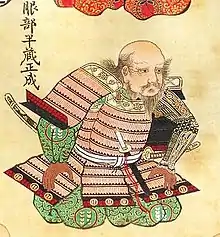
Hattori Hanzō
- January 27 – Sir Francis Drake, English explorer, sea captain, privateer, navigator, slaver, pirate and politician (b. c. 1540)[96]
- February 7 – George I, Landgrave of Hesse-Darmstadt (b. 1547)
- February 17 – Friedrich Sylburg, German classical scholar (b. 1536)
- February 19 – Blaise de Vigenère, French cryptographer, diplomat, scientist, and author (b. 1523)
- March 23 – Henry Unton, English diplomat (b. 1557)
- March 27 – Frederick IV of Liegnitz, German noble (b. 1552)
- April 4 – Philip II, Duke of Brunswick-Grubenhagen (b. 1533)
- May – Janet Fockart, Scottish merchant and moneylender
- May 5 – Catherine de Montpensier, politically active French duchess (b. 1552)
- May 6 – Giaches de Wert, Flemish composer (b. 1535)
- May 31 – John Lesley, Scottish bishop (b. 1527)
- June 10 – John Louis I, Count of Nassau-Wiesbaden-Idstein, Germany noble (b. 1567)
- July 10 – Alessandro Alberti, Italian painter (b. 1551)
- July 23 – Henry Carey, 1st Baron Hunsdon (b. 1526)
- August 11 – Hamnet Shakespeare, son of William Shakespeare (b. 1585)
- September 9 – Anna Jagiellon, queen of Poland (b. 1523)
- September 14 – Francisco de Toledo, Spanish Catholic cardinal (b. 1532)
- September 15 – Leonhard Rauwolf, German physician and botanist (b. 1535)
- October 3 – Florent Chrestien, French writer (b. 1541)
- October 26 – István Esterházy, Hungarian noble (b. 1572)
- November 1 – Pierre Pithou, French lawyer and scholar (b. 1539)[97]
- November 10 – Peter Wentworth, English Puritan politician (b. 1530)
- November 29
- William Gibson (martyr), English Catholic martyr
- Venerable William Knight, English Catholic martyr (b. 1572)
- December 27 – Pietro Pontio, Italian music theorist and composer (b. 1532)
- date unknown
- Jean Bodin, French jurist (born 1530)
- Anna Wecker, German writer
- Hattori Hanzō, Japanese ninja under Tokugawa Ieyasu (b. 1541)
- probable – Henry Willobie, English poet (b. 1575)
1597
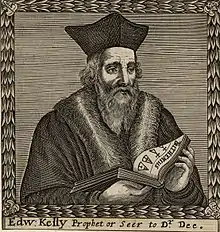
Edward Kelley

Saint Peter Canisius
- January 29
- February 2 – James Burbage, English actor
- February 5
- Francisco Blanco, Spanish Franciscan and Roman Catholic priest, missionary, martyr and saint (b. 1570)
- Gonsalo Garcia, Portuguese Franciscan and Roman Catholic priest, missionary, martyr and saint (b. 1557)
- Paulo Miki, Japanese Roman Catholic priest, martyr and saint (b. c.1562)
- Philip of Jesus, Mexican Roman Catholic priest, missionary, martyr and saint (b. 1572)
- 26 Martyrs of Japan
- February 6 – Franciscus Patricius, Italian philosopher and scientist (b. 1529)
- February 16 – Gilbert Génébrard, French Roman Catholic archbishop (b. 1535)
- March 6 – William Brooke, 10th Baron Cobham, English noble and politician (b. 1527)
- April 2 – Blas Valera, Peruvian historian (b. 1545)
- April 16 – Caspar Cruciger the Younger, German theologian (b. 1525)
- June 6 – William Hunnis, English poet
- June 8 – Barbara of Hesse (b. 1536)
- June 9 – José de Anchieta, Spanish Jesuit missionary (b. 1534)
- June 18 – Markus Fugger, German businessman (b. 1529)
- June 20 – Willem Barents, Dutch navigator and explorer (b. c. 1550)[98]
- July 8 – Luís Fróis, Portuguese Jesuit missionary (b. 1532)
- July 19 – Gunilla Bielke, Queen of Sweden (b. 1568)
- July 20 – Franciscus Raphelengius, Dutch printer (b. 1539)
- July 22 – Gabriele Paleotti, Italian Roman Catholic cardinal (b. 1522)
- August 27
- September 3 – Jakobea of Baden, Margravine of Baden by birth, Duchess of Jülich-Cleves-Berg (b. 1558)
- September 9 – Helena Magenbuch, German pharmacist (b. 1523)
- September 20 – Archduchess Gregoria Maximiliana of Austria, Austrian archduchess (b. 1581)
- September 30 – William I, Count of Schwarzburg-Frankenhausen (b. 1534)
- October 4 – Sarsa Dengel, Emperor of Ethiopia (b. 1550)[99]
- October 19 – Ashikaga Yoshiaki, Japanese shōgun (b. 1537)
- October 23 – Cyriakus Schneegass, German hymnwriter (b. 1546)
- October 27 – Alfonso II d'Este, Duke of Ferrara, Italian noble (b. 1533)
- November 1 – Edward Kelley, English spirit medium (b. 1555)
- November 11 – Gustav of Saxe-Lauenburg, German noble (b. 1570)
- November 6 – Infanta Catherine Michelle of Spain (b. 1567)
- December 17 – Frederick, Count Palatine of Zweibrücken-Vohenstrauss-Parkstein (b. 1557)
- December 21 – Petrus Canisius, Dutch Jesuit priest and saint (b. 1521)[100]
date unknown - Margaretha Coppier, Dutch heroine (b. 1516) 1598
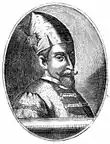
Tsar Feodor I of Russia

King Philip II of Spain
- January 8 – John George, Elector of Brandenburg, Margrave and Elector of Brandenburg and Duke of Prussia (b. 1525)
- January 9 – Jasper Heywood, English Jesuit classicist and translator (b. 1553)
- January 16 – Tsar Feodor I of Russia (b. 1557)[101]
- February 10 – Anne of Austria, Queen of Poland (b. 1573)
- March 4 or March 5 – Lucas Maius, Lutheran Reformation pastor, theologian and playwright (b. 1522)
- March 28 – Michele Bonelli, Italian Catholic cardinal (b. 1541)
- April 8 – Ludwig Helmbold, German classical singer (b. 1532)
- April 10 – Jacopo Mazzoni, Italian philosopher (b. 1548)
- April 19
- May 3 – Anna Guarini, Italian singer (b. 1563)
- May 18 – Philipp of Bavaria, German Catholic cardinal (b. 1576)
- June – Emery Molyneux, English maker of globes and instruments (date of birth unknown)
- June 28 – Abraham Ortelius, Flemish cartographer and geographer (b. 1527)
- June 25 – Giacomo Gaggini, Italian artist (b. 1517)
- August 4 – William Cecil, 1st Baron Burghley, English statesman (b. 1520)[102]
- August 9 – Andreas Angelus, German pastor, teacher, chronicler of the Mark of Brandenburg (b. 1561)
- September 13 – Philip II of Spain (b. 1527)[103]
- September 18 – Toyotomi Hideyoshi, Japanese warlord (b. 1537)
- October 11 – Joachim Camerarius the Younger, German scientist (b. 1534)
- November 12 – Johannes Schenck von Grafenberg, German physician (b. 1530)
- December 6 – Paolo Paruta, Italian historian (b. 1540)[104]
- December 15 – Philips of Marnix, Lord of Saint-Aldegonde, Dutch writer and statesman (b. 1538)[105]
- December 16 – Yi Sun-sin, Korean naval leader (b. 1545)
- December 31 – Heinrich Rantzau, German humanist writer, astrologer, and astrological writer (b. 1526)
- date unknown
1599
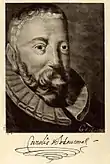
Cornelis de Houtman
%252C_m%C3%A5lad_1688-1703_-_Skoklosters_slott_-_98170.tif.png.webp)
Andrew Báthory
- January 13 – Edmund Spenser, English poet (b. 1552)[106]
- January 22 – Cristofano Malvezzi, Italian composer (b. 1547)
- February 8 – Robert Rollock, Scottish Presbyterian, first principal of the university of Edinburgh (b. 1555)
- March 19 – Stanisław Radziwiłł, Grand Marshal of Lithuania (b. 1559)
- April 10 – Gabrielle d'Estrées, mistress of King Henry IV of France (b. 1573)[107]
- April 14 – Henry Wallop, English statesman (b. c. 1540)
- April 22 – Lorenz Scholz von Rosenau, German botanist (b. 1552)
- April 27 – Maeda Toshiie, Japanese samurai and warlord (b. 1538)
- May 12 – Sultan Murad Mirza, Mughal prince (b. 1570)
- May 28 – Maria of Nassau, Dutch Countess (b. 1539)
- June 2 – Philipp V, Count of Hanau-Lichtenberg (b. 1541)
- June 14 – Kōriki Masanaga, Japanese military commander (b. 1558)
- June 29 – Archduchess Catherine Renata of Austria, Austrian archduchess (b. 1576)
- July – Kwon Yul, Korean military commander (b. 1537)
- July 11 – Chōsokabe Motochika, Japanese Sengoku Period daimyō
- August 22 – Luca Marenzio, Italian composer (b. 1553)
- September 1 – Cornelis de Houtman, Dutch explorer (b.1565)
- September 11 – Beatrice Cenci, Italian noblewoman (executed for patricide) (b. 1577)[108]
- August 8 – Song Ik-pil, Korean scholar (b. 1534)
- October 18 – Daniel Adam z Veleslavína, Czech lexicographer (b. 1546)
- November 3 – Andrew Báthory, deposed Prince of Transylvania (decapitated) (b. c. 1563)
- November 7 – Gasparo Tagliacozzi, Italian surgeon (b. 1545)
- November 8 – Francisco Guerrero, Spanish composer (b. 1528)[109]
- November 22 – Nanbu Nobunao, Japanese daimyō (b. 1546)
- December 13 – Enrico Caetani, Italian Catholic cardinal (b. 1550)
- December 14 – Joan Boyle, English noble, first spouse of Richard Boyle, 1st Earl of Cork (b. 1578)
- December 27 – Francisco Pérez de Valenzuela, Spanish noble (b. 1528)
- After December 18 – Minye Kyawswa II of Ava, Burmese defecting crown prince of the Toungoo Empire (killed by invading forces) (b. 1567)
- date unknown – Chand Bibi, Indian regent and warrior (b. 1550)
References
- Hans Delbrück (1975). History of the Art of War Within the Framework of Political History: The Modern Era. Greenwood Press. p. 195. ISBN 978-0-8371-8165-3.
- "Anne of Denmark: Biography". www.undiscoveredscotland.co.uk. Retrieved 7 May 2019.
- Parminder Summon (2004). Summon's Christian Miscellany. Lion. p. 35. ISBN 978-0-7459-5174-4.
- Nicola Mary Sutherland (2002). Henry IV of France and the Politics of Religion: The path to Rome. Intellect Books. p. 373. ISBN 978-1-84150-702-6.
- Lawrence Normand; Gareth Roberts (2000). Witchcraft in Early Modern Scotland: James VI's Demonology and the North Berwick Witches. University of Exeter Press. p. 141. ISBN 978-0-85989-680-1.
- ʿAbd al-Raḥmān ibn ʿAbd Allāh al-Saʿdī (1 January 1999). Timbuktu and the Songhay Empire: Al-Saʻdī's Taʼrīkh Al-Sūdān Down to 1613 and Other Contemporary Documents. BRILL. p. 259. ISBN 90-04-11207-3.
- Williams, Hywel (2005). Cassell's Chronology of World History. London: Weidenfeld & Nicolson. pp. 233–238. ISBN 0-304-35730-8.
- "Britain's oldest building firm collapses". BBC News. 2019-07-04. Retrieved 2019-07-04.
- Noel Grove (1997). National Geographic Atlas of World History. National Geographic Society. p. 385. ISBN 978-0-7922-7023-2.
- The Book Review. C. Chari for Perspective Publications. 1996. p. 38.
- Commentarii Collegii Conimbricensis Societatis Jesu in octo libros physicorum Aristotelis Stagyritæ.
- Nicola Mary Sutherland (2002). Henry IV of France and the Politics of Religion: The path to Rome. Intellect Books. p. 445. ISBN 978-1-84150-702-6.
- James S. Donnelly (2004). Encyclopedia of Irish History and Culture. Macmillan Reference USA. p. xxix. ISBN 978-0-02-865699-1.
- Stephen R. Turnbull (1996). The Samurai: A Military History. Psychology Press. p. 208. ISBN 978-1-873410-38-7.
- Metzger, Bruce M. (1977). "VII The Latin Versions". The Early Versions of the New Testament. Oxford: Clarendon Press. p. 349.
- "Historical Events for Year 1593 | OnThisDay.com". Historyorb.com. Retrieved 2018-04-05.
- Paweł Jasienica (1987). The Commonwealth of Both Nations: The Silver Age. American Institute of Polish Culture. p. 156. ISBN 978-0-87052-394-6.
- Kenneth B. Lee; Kong-bok Yi (1997). Korea and East Asia: The Story of a Phoenix. Greenwood Publishing Group. p. 102. ISBN 978-0-275-95823-7.
- Castex, Jean-Claude (2012). Dictionnaire des Batailles navales franco-anglaises. Les Éditions du Phare-Ouest. p. 59. ISBN 9782921668194.
- Cox, Michael, ed. (2004). The Concise Oxford Chronology of English Literature. Oxford University Press. ISBN 0-19-860634-6.
- Hotson, Leslie (1925). The Death of Christopher Marlowe. London: Nonesuch Press.
- Bèze, Théodore (2010). Correspondance. Tome XXXIV, 1593. Librairie Droz. p. 165. ISBN 9782600314688.
- Branka Magaš (2007). Croatia Through History: The Making of a European State. Saqi. p. 95. ISBN 978-0-86356-775-9.
- Le Roux, Nicolas (May 13, 2013). La Faveur du Roi: Mignons et courtisans au temps des derniers valois (vers 1547–vers 1589). Éditions Champ Vallon. ISBN 9782876737518.
- Lacotte, Daniel (2016). Les Mots célèbres de l'histoire. Albin Michel. ISBN 9782226379887.
- Harleian MS 7553.
- Tietoa Laukaasta – Laukaa.fi (in Finnish)
- "Khwaja Usman". Banglapedia. Retrieved 23 September 2018.
- Chambers, Anne (2003). Ireland's Pirate Queen: The True Story of Grace O'Malley (2nd ed.). New York: MJF Books. ISBN 978-1-56731-858-6.
- Clare McManus, Women on the Renaissance Stage: Anna of Denmark and Female Masquing in the Stuart Court, 1590–1618 (Manchester, 2002), p. 83.
- Russia. Posolstvo (Great Britain) (1994). England and the North: The Russian Embassy of 1613-1614. American Philosophical Society. p. 188. ISBN 978-0-87169-210-8.
- Palmer, Alan; Veronica (1992). The Chronology of British History. London: Century Ltd. pp. 163–165. ISBN 0-7126-5616-2.
- Green, Toby (21 March 2019). A fistful of shells : West Africa from the rise of the slave trade to the age of revolution. Chicago. ISBN 9780226644578. OCLC 1051687994.
- George Nedungatt (2001). The Synod of Diamper Revisited. Pontificio Istituto Orientale. p. 137. ISBN 978-88-7210-331-9.
- William J. Griswold (1983). The Great Anatolian Rebellion, 1000-1020/1591-1611. K. Schwarz. p. 17. ISBN 978-3-922968-34-4.
- "Jaakko Ilkka's biography". Archived from the original on 5 June 2016. Retrieved 13 July 2014.
- Emily C. Bartels (April 2006). "Too Many Blackamoors: Deportation, Discrimination, and Elizabeth I". SEL: Studies in English Literature 1500–1900. Rice University. 46 (2): 305–322. doi:10.1353/sel.2006.0012. JSTOR 3844644. S2CID 154728438.
In 1596, Queen Elizabeth issued an 'open letter' to the Lord Mayor of London, announcing that 'there are of late divers black-moores brought into this realme, of which kinde of people there aire allready here to manie,' and ordering that they be deported from the country.
- Stratton, J.M. (1969). Agricultural Records. John Baker. ISBN 0-212-97022-4.
- Chris Cook; Philip Broadhead (2 October 2012). The Routledge Companion to Early Modern Europe, 1453-1763. Routledge. p. 110. ISBN 978-1-134-13065-8.
- Nuijasota – Ilmajoki (in Finnish)
- John Hudson Tiner (1999). Johannes Kepler: Giant of Faith and Science. Mott Media. p. 86. ISBN 978-0-915134-11-3.
- DK (1 October 2009). War. Dorling Kindersley Limited. p. 403. ISBN 978-1-4053-4778-5.
- Lisa Jardine; Professor of Renaissance Studies Lisa Jardine (1974). Francis Bacon: Discovery and the Art of Discourse. Cambridge University Press. p. 228. ISBN 978-0-521-20494-1.
- "From liquid to vapor and back: origins". Special Collections Department. University of Delaware Library. Retrieved March 12, 2007.
- Scott M. Manetsch (2000). Theodore Beza and the Quest for Peace in France: 1572 - 1598. BRILL. p. 332. ISBN 90-04-11101-8.
- Tommaso Campanella (30 March 2011). Selected Philosophical Poems of Tommaso Campanella: A Bilingual Edition. University of Chicago Press. p. 6. ISBN 978-0-226-09205-8.
- Harry S. Ashmore (1962). Encyclopaedia Britannica: A New Survey of Universal Knowledge. Encyclopaedia Britannica. p. 279.
- Turnbull, Stephen (2002). Samurai Invasion: Japan's Korean War. London: Cassell. ISBN 978-0-304-35948-6.
- Ottavio Rinuccini's libretto survives complete but only fragments of the music are known.
- MacCulloch, Diarmaid (2013). Silence: A Christian History. London: Allen Lane. ISBN 9781846144264.
- Denis Crispin Twitchett; John King Fairbank; Frederick W. Mote (1978). The Cambridge History of China. Cambridge University Press. pp. 349–. ISBN 978-0-521-24333-9.
- William R. Jones (2004). "The Mists of Error Withdrawn": Elizabethan Satire, Cultural Criticism, and the Bishops' Ban of 1599. University of California, Santa Cruz. p. 69.
- Sir John Alexander Hammerton (1975). Concise Universal Biography: A Dictionary of the Famous Men and Women of All Countries and All Times, Recording the Lives of More Than 20,000 Persons and Profusely Illustrated with Authentic Portraits and Other Pictorial Documents. Gale Research Company. p. 1347. ISBN 978-0-8103-4209-5.
- Brown, Cedric Clive (1993). Patronage, Politics, and Literary Traditions in England, 1558-1658. Wayne State University Press. pp. 62–63. ISBN 978-0-8143-2417-2.
- The New Encyclopædia Britannica. Encyclopædia Britannica. 1983. p. 822. ISBN 978-0-85229-400-0.
- Alexander Hopkins McDonnald (1951). The Encyclopedia Americana. Americana Corporation. p. 87.
- Elizabeth Story Donno (1 April 1983). The Renaissance: Excluding Drama. Macmillan International Higher Education. p. 104. ISBN 978-1-349-17058-6.
- Pierre Gassendi; Oliver Thill (2002). The Life of Copernicus (1473-1543). Xulon Press. p. 317. ISBN 978-1-59160-193-7.
- "John Amos Comenius | Czech educator | Britannica". www.britannica.com. Retrieved 16 March 2022.
- Paul E. Eisler (1972). World Chronology of Music History: 1594-1684. Oceana Publications. p. 363. ISBN 978-0-379-16082-6.
- Amy Marie Charles (1977). A Life of George Herbert. Cornell University Press. p. 15. ISBN 978-0-8014-1014-7.
- R. Ward Bissell; Roger Ward Bissell (1999). Artemisia Gentileschi and the Authority of Art: Critical Reading and Catalogue Raisonné. Pennsylvania State University Press. p. 2. ISBN 978-0-271-01787-7.
- James Vinson; D. L. Kirkpatrick (1979). Novelists and Prose Writers. Macmillan. p. 1250. ISBN 978-0-333-25292-5.
- Ronald H. Fritze; William B. Robison (1996). Historical Dictionary of Stuart England, 1603-1689. Greenwood Publishing Group. p. 228. ISBN 978-0-313-28391-8.
- Stanley Wells (28 November 2002). Shakespeare Survey. Cambridge University Press. p. 145. ISBN 978-0-521-52374-5.
- John Cottingham (25 September 1992). The Cambridge Companion to Descartes. Cambridge University Press. p. 22. ISBN 978-0-521-36696-0.
- The Ukrainian Review. Association of Ukrainians in Great Britain, Limited. 1966. p. 28.
- Ronald H. Fritze; William B. Robison (1996). Historical Dictionary of Stuart England, 1603-1689. Greenwood Publishing Group. p. 177. ISBN 978-0-313-28391-8.
- Jolande van der Klis (2000). The Essential Guide to Dutch Music: 100 Composers and Their Work. Amsterdam University Press. p. 179. ISBN 978-90-5356-460-8.
- Oechslin, Werner (1972). "BUONAMICI, Francesco". Dizionario Biografico degli Italiani (in Italian). Vol. 15. Archived from the original on 23 January 2020.
- The Encyclopedia Americana. Grolier Incorporated. 1999. p. 215. ISBN 978-0-7172-0131-0.
- Rudolf Wittkower (1981). Gian Lorenzo Bernini: The Sculptor of the Roman Baroque. Cornell University Press. p. 2. ISBN 978-0-8014-1430-5.
- Ronald Shaw-Kennedy (1978). Venice Rediscovered. Associated University Presse. p. 23. ISBN 978-0-8453-1484-5.
- Chisholm, Hugh, ed. (1911). . Encyclopædia Britannica. Vol. 25 (11th ed.). Cambridge University Press. p. 1040.
- Hans Kühner (1958). Encyclopedia of the Papacy. Philosophical Library. p. 193. ISBN 978-0-8022-0900-9.
- "Anthony van Dyck". Netherlands Institute of Art. Retrieved 2021-03-20.
- Martyn Bennett (21 August 2006). Oliver Cromwell. Routledge. pp. 3–. ISBN 978-1-134-36495-4.
- Lawrence Thompson (1990). The Princeton University Library Chronicle. Friends of the Princeton University Library. p. 98.
- "Sixtus V | pope". Encyclopedia Britannica. Retrieved 7 May 2019.
- Otto, Jochen; Baboukis, Translated from the German by Johanna M. (2009). "Cujas, Jacques". The Oxford International Encyclopedia of Legal History. Oxford University Press. ISBN 978-0-19-513405-6.
- Frederic, Louis; Louis-Frédéric (2002). Japan Encyclopedia. Harvard University Press. pp. xvii. ISBN 978-0-674-01753-5.
- Y Cymmrodor: The Magazine of the Honourable Society of Cymmrodorion ... Cymmrodorion Society. 1929. p. 32.
- "Gregory XIV | pope". Encyclopedia Britannica. Retrieved 6 May 2019.
- "Innocent IX | pope". Encyclopedia Britannica. Retrieved 24 January 2021.
- Jennifer Speake (2003). Literature of Travel and Exploration: G to P. Taylor & Francis. p. 808. ISBN 978-1-57958-424-5.
- The Encyclopedia Americana. Grolier Incorporated. 1997. p. 114. ISBN 978-0-7172-0129-7.
- John Penry (1944). The Notebook of John Penry, 1593. Offices of the Royal Historical Society. p. vii.
- British Museum. Department of Printed Books. King's Library; William Shakespeare; Christopher Marlowe (1964). William Shakespeare, 1564-1616, and Christopher Marlowe, 1564-1593: An Exhibition of Books, Manuscripts, and Other Illustrative Material Held in the King's Library of the British Museum, 23 April to 12 July, 1964. British Museum. p. 4.
- Clara Marvin (15 October 2013). Giovanni Pierluigi da Palestrina: A Research Guide. Routledge. p. 10. ISBN 978-1-135-61754-7.
- Abel Lefranc (1988). Under the Mask of William Shakespeare. Merlin. p. 72. ISBN 978-0-86303-352-0.
- Tom Nichols (1999). Tintoretto: Tradition and Identity. Reaktion Books. p. 245. ISBN 978-1-86189-120-4.
- Belgian Laces. Belgian Researchers, Incorporated. 1993. p. 2.
- Coote, Charles Henry (1889). . In Stephen, Leslie (ed.). Dictionary of National Biography. Vol. 20. London: Smith, Elder & Co. pp. 281–284.
- Johann Wolfgang von Goethe (1979). Torquato Tasso: A Play. Manchester University Press. p. 4. ISBN 978-0-7190-0720-0.
- Montague Summers (1928). The Vampire: His Kith and Kin. K. Paul, Trench, Trubner & Company, Limited. p. 132.
- Neville Williams (1973). Francis Drake. Weidenfeld and Nicolson. p. 220. ISBN 978-0-297-76685-8.
- R. W. Lamb (1998). Annales Phaedriani, 1596-1996. R.W. Lamb. p. 2. ISBN 978-0-9533361-0-4.
- Barwolt Sijbrand Ebbinge; P. S. Tomkovich (2000). Heritage of the Russian Arctic: Research, Conservation, and International Co-operation : Proceedings of the International Scientific Willem Barents Memorial Arctic Conservation Symposium, Held in Moscow, Russia, 10-14 March 1998. Ecopros Publishers. p. 1. ISBN 978-5-88621-057-6.
- Saheed A. Adejumobi (2007). The History of Ethiopia. Greenwood Publishing Group. p. 169. ISBN 978-0-313-32273-0.
- John McClintock (1981). Cyclopedia of Biblical, Theological, and Ecclesiastical Literature. Baker Book House. p. 74. ISBN 978-0-8010-6123-3.
- Perrie, Maureen (1995). Pretenders and popular monarchism in early modern Russia: the false tsars of the Time of Troubles. Cambridge New York: Cambridge University Press. p. 21. ISBN 9780521472746.
- Christopher Maginn (15 March 2012). William Cecil, Ireland, and the Tudor State. OUP Oxford. p. 191. ISBN 978-0-19-969715-1.
- Fernand Braudel (1995). The Mediterranean and the Mediterranean World in the Age of Philip II: Volume II. University of California Press. p. 1234. ISBN 978-0-520-20330-3.
- The Catholic Encyclopedia: New Mexico-Philip. Appleton. 1911. p. 510.
- May King; David Leer Ringo; William K. Barnarad (2001). Supplemental research and history (volume XIV). McDowell Publications for the Freeborn Family Association. p. 24.
- Colin Burrow (1996). Edmund Spenser. Oxford University Press. p. 1. ISBN 978-0-7463-0750-2.
- St James Press; Anthony Levi; Retired Professor of French Anthony Levi (1992). Guide to French Literature: Beginnings to 1789. St. James Press. p. 10. ISBN 978-1-55862-159-6.
- Bettina Liebowitz Knapp (18 October 1985). French Theatre 1918–1939. Macmillan International Higher Education. p. 79. ISBN 978-1-349-17985-5.
- Anuario interamericano de investigación musical: Yearbook for inter-American musical research. Anuário interamericano de pesquisa musical. University of Texas at Austin. 1972. p. 9.
Wikimedia Commons has media related to 1590s.
This article is issued from Wikipedia. The text is licensed under Creative Commons - Attribution - Sharealike. Additional terms may apply for the media files.

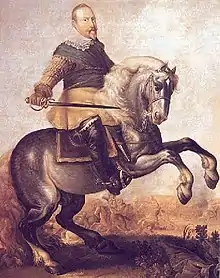



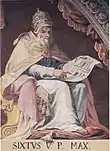


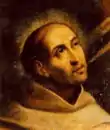
.jpg.webp)

